Lab Publications and Conferences
Peer Reviewed Publications
Voxel-Level Approach to Brain Age Prediction: A Method to Assess Regional Brain Aging
Authors: Gianchandani, N. , Dibaji, M., Ospel, J., Vega, F., Bento, M., MacDonald, M.E., and Souza, R. A
Date: 2024-04-25
Journal: Journal of Machine Learning for Biomedical Imaging: Volume 2, April 2024 issue
Brain aging is a regional phenomenon, a facet that remains relatively under-explored within the realm of brain age prediction research using machine learning methods. Voxel-level predictions can provide localized brain age estimates that can provide granular insights into the regional aging processes. This is essential to understand the differences in aging trajectories in healthy versus diseased subjects. In this work, a deep learning-based multitask model is proposed for voxel-level brain age prediction from T1-weighted magnetic resonance images. The proposed model outperforms the models existing in the literature and yields valuable clinical insights when applied to both healthy and diseased populations. Regional analysis is performed on the voxel-level brain age predictions to understand aging trajectories of known anatomical regions in the brain and show that there exist disparities in regional aging trajectories of healthy subjects compared to ones with underlying neurological disorders such as Dementia and more specifically, Alzheimer’s disease.
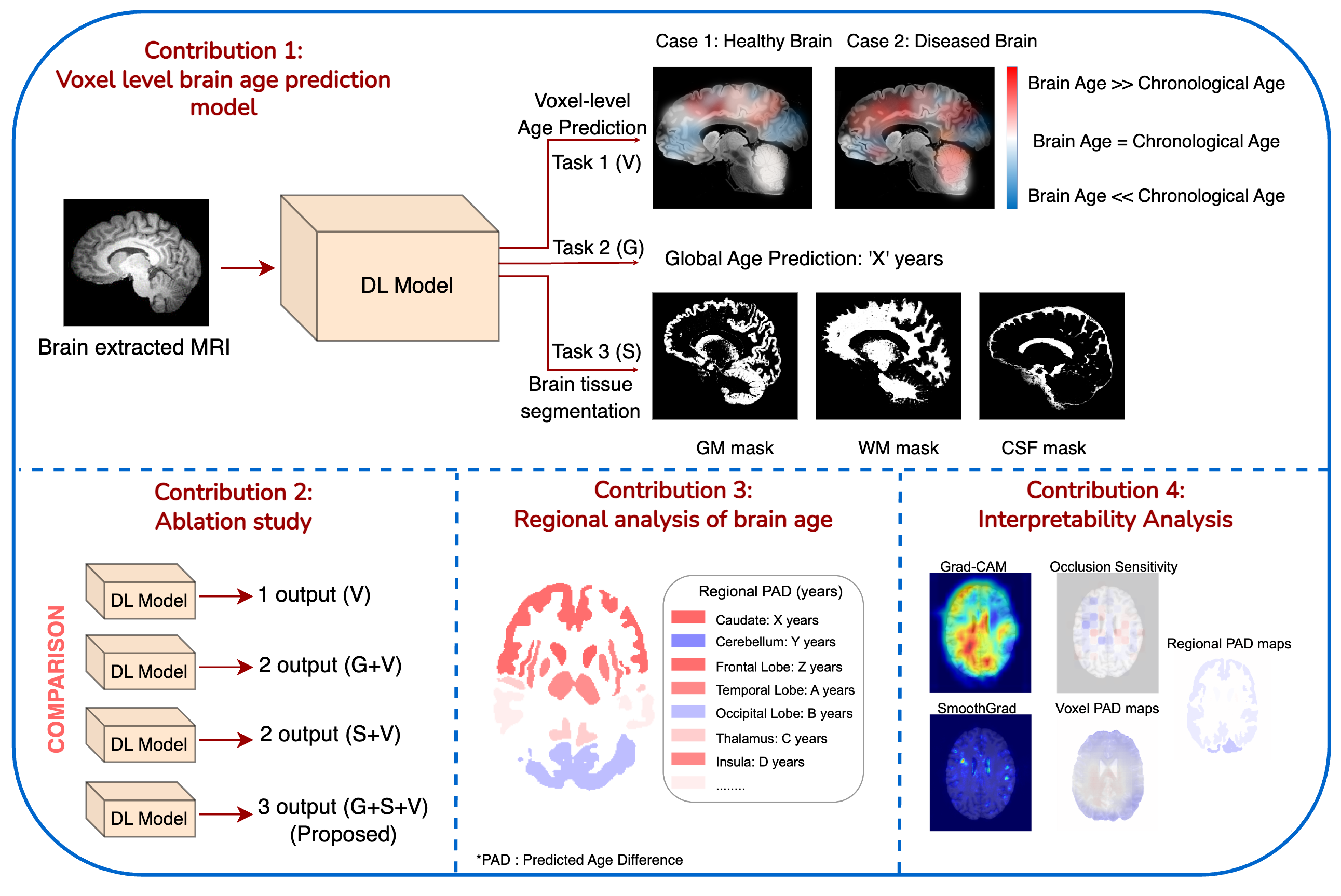
Read more
Image Translation for Estimating Two-Dimensional Axial Amyloid-Beta PET From Structural MRI
Authors: Vega, F., Addeh, A., Ganesh, A., Smith, E.E., and MacDonald, M.E.
Date: 2024-03-11
Journal: Journal of Magnetic Resonance Imaging: Volume 59, Issue 3
Amyloid-beta and brain atrophy are hallmarks for Alzheimer's Disease that can be targeted with positron emission tomography (PET) and MRI, respectively. MRI is cheaper, less-invasive, and more available than PET. There is a known relationship between amyloid-beta and brain atrophy, meaning PET images could be inferred from MRI. The purpose of this project is to build an image translation model using a Conditional Generative Adversarial Network able to synthesize Amyloid-beta PET images from structural MRI.
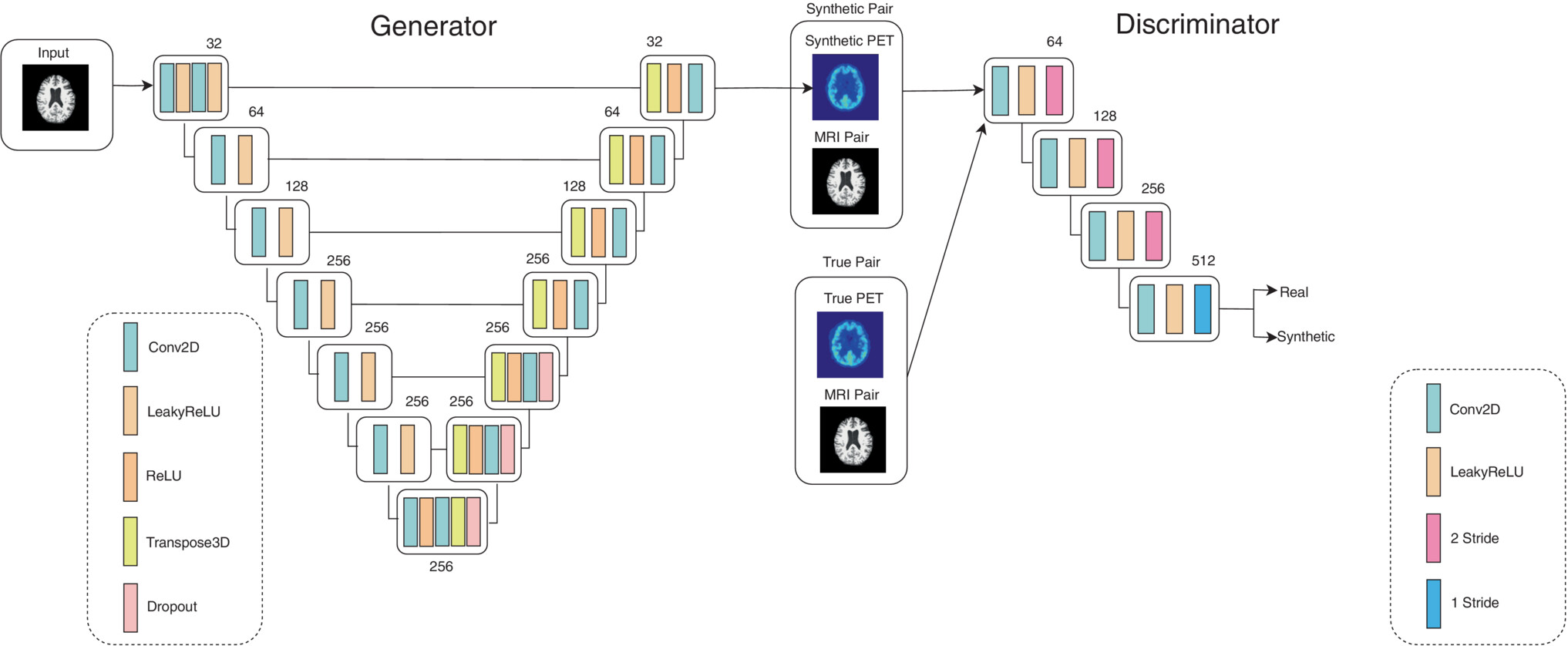
Read more
A Statistical Method for Image-Mediated Association Studies Discovers Genes and Pathways Associated with Four Brain Disorders
Authors: He, J., Antonyan, L., Zhu, H., Ardilla, K., Li, Q., Enoma, D., Zhang, W., Liu, A., Chekouo, T., Cao, B., MacDonald, M.E., Arnold, P., and Long, Q.
Date: 2024-01-04
Journal: The American Journal of Human Genetics: Volume 111, Issue 1
Brain imaging and genomics are critical tools enabling characterization of the genetic basis of brain disorders. However, imaging large cohorts is expensive and may be unavailable for legacy datasets used for genome-wide association studies (GWASs). Using an integrated feature selection/aggregation model, we developed an image-mediated association study (IMAS), which utilizes borrowed imaging/genomics data to conduct association mapping in legacy GWAS cohorts. By leveraging the UK Biobank image-derived phenotypes (IDPs), the IMAS discovered genetic bases underlying four neuropsychiatric disorders and verified them by analyzing annotations, pathways, and expression quantitative trait loci (eQTLs). A cerebellar-mediated mechanism was identified to be common to the four disorders. Simulations show that, if the goal is identifying genetic risk, our IMAS is more powerful than a hypothetical protocol in which the imaging results were available in the GWAS dataset. This implies the feasibility of reanalyzing legacy GWAS datasets without conducting additional imaging, yielding cost savings for integrated analysis of genetics and imaging.
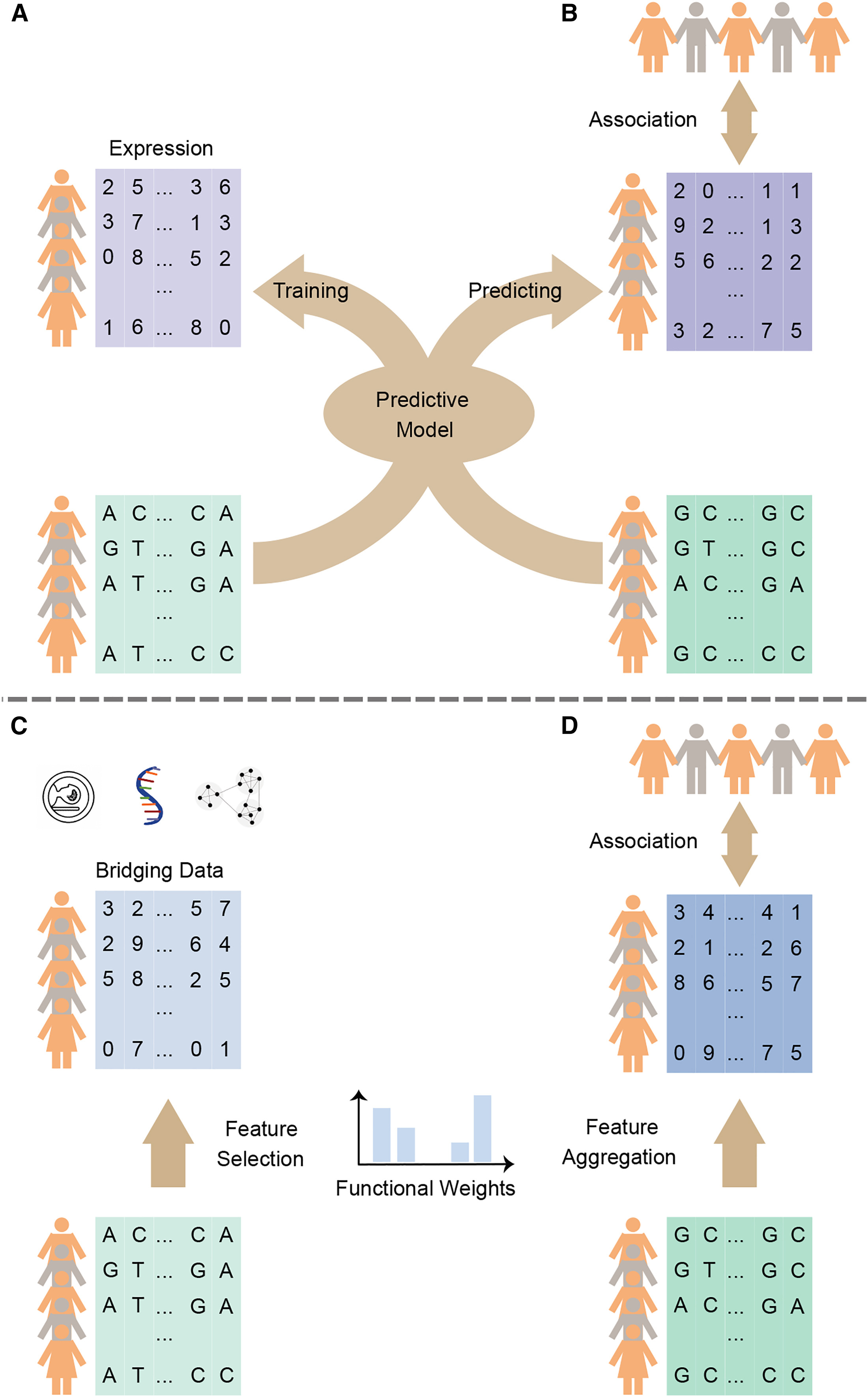
Read more
Correspondence between BOLD fMRI task activation and cerebrovascular reactivity across the cerebral cortex
Authors: Williams, R, Specht, J., Mazerolle, E., Lebel, M.R., MacDonald, M.E., and Pike, G.B.
Date: 2023-05-08
Journal: Frontiers in Physiology - Medical Physics and Imaging: Volume 14
BOLD sensitivity to baseline perfusion and blood volume is a well-acknowledged fMRI confound. Vascular correction techniques based on cerebrovascular reactivity (CVR) might reduce variance due to baseline cerebral blood volume, however this is predicated on an invariant linear relationship between CVR and BOLD signal magnitude. Cognitive paradigms have relatively low signal, high variance and involve spatially heterogenous cortical regions; it is therefore unclear whether the BOLD response magnitude to complex paradigms can be predicted by CVR. The feasibility of predicting BOLD signal magnitude from CVR was explored in the present work across two experiments using different CVR approaches. The first utilized a large database containing breath-hold BOLD responses and 3 different cognitive tasks. The second experiment, in an independent sample, calculated CVR using the delivery of a fixed concentration of carbon dioxide and a different cognitive task. An atlas-based regression approach was implemented for both experiments to evaluate the shared variance between task-invoked BOLD responses and CVR across the cerebral cortex. Both experiments found significant relationships between CVR and task-based BOLD magnitude, with activation in the right cuneus and paracentral gyrus , and the left pars opercularis , superior frontal gyrus and inferior parietal cortex strongly predicted by CVR. The parietal regions bilaterally were highly consistent, with linear regressions significant in these regions for all four tasks. Group analyses showed that CVR correction increased BOLD sensitivity. Overall, this work suggests that BOLD signal response magnitudes to cognitive tasks are predicted by CVR across different regions of the cerebral cortex, providing support for the use of correction based on baseline vascular physiology.
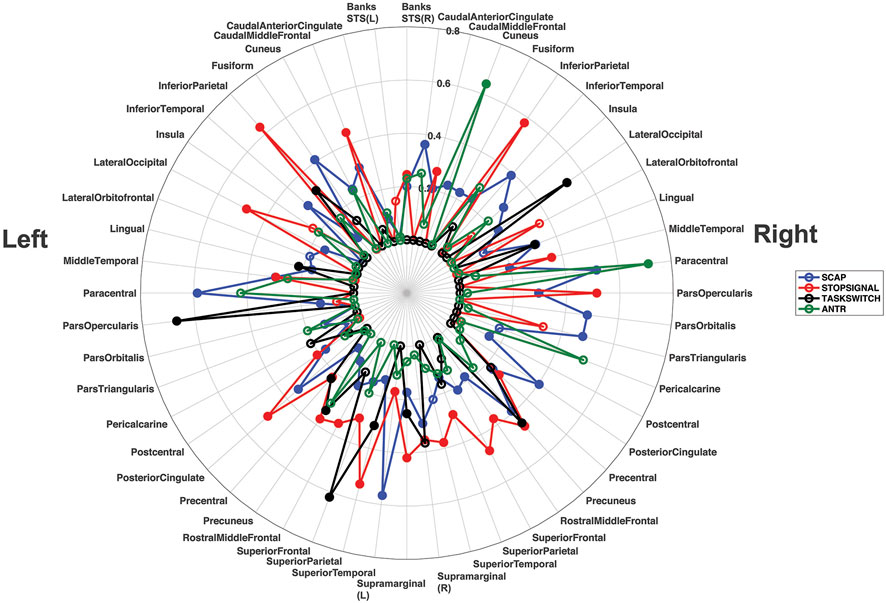
Read more
Direct Machine Learning Reconstruction of Respiratory Variation Waveforms from Resting State fMRI Data in a Pediatric Population
Authors: Addeh, A., Vega, F., Medi, P., Williams, R.J, Pike, G.B, and MacDonald, M.E.
Date: 2023-04-01
Journal: NeuroImage: Volume 269
In many functional magnetic resonance imaging (fMRI) studies, respiratory signals are unavailable or do not have acceptable quality due to issues with subject compliance, equipment failure or signal error. In large databases, such as the Human Connectome Projects, over half of the respiratory recordings may be unusable. As a result, the direct removal of low frequency respiratory variations from the blood oxygen level-dependent (BOLD) signal time series is not possible. This study proposes a deep learning-based method for reconstruction of respiratory variation (RV) waveforms directly from BOLD fMRI data in pediatric participants (aged 5 to 21 years old), and does not require any respiratory measurement device. To do this, the Lifespan Human Connectome Project in Development (HCP-D) dataset, which includes respiratory measurements, was used to both train a convolutional neural network (CNN) and evaluate its performance. Results show that a CNN can capture informative features from the BOLD signal time course and reconstruct accurate RV timeseries, especially when the subject has a prominent respiratory event. This work advances the use of direct estimation of physiological parameters from fMRI, which will eventually lead to reduced complexity and decrease the burden on participants because they may not be required to wear a respiratory bellows.
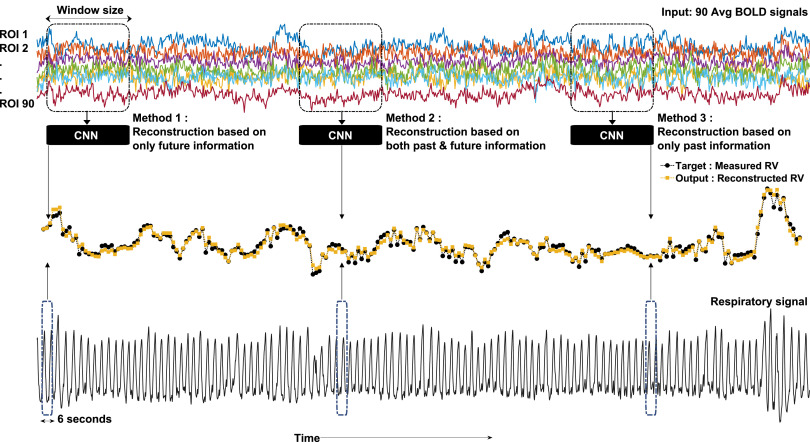
Read more
Closed-loop vasculature network design for bioprinting large, solid tissue scaffolds
Authors: Kumar, H., Dixit, K., Sharma, R., MacDonald, M.E., Sinha, N., and Kim, K.
Date: 2023-02-14
Journal: Biofabrication: Volume 15, Number 2
Vascularization is an indispensable requirement for fabricating large solid tissues and organs. The natural vasculature derived from medical imaging modalities for large tissues and organs are highly complex and convoluted. However, the present bioprinting capabilities limit the fabrication of such complex natural vascular networks. Simplified bioprinted vascular networks, on the other hand, lack the capability to sustain large solid tissues. This work proposes a generalized and adaptable numerical model to design the vasculature by utilizing the tissue/organ anatomy. Starting with processing the patient's medical images, organ structure, tissue-specific cues, and key vasculature tethers are determined. An open-source abdomen magnetic resonance image dataset was used in this work. The extracted properties and cues are then used in a mathematical model for guiding the vascular network formation comprising arterial and venous networks. Next, the generated three-dimensional networks are used to simulate the nutrient transport and consumption within the organ over time and the regions deprived of the nutrients are identified. These regions provide cues to evolve and optimize the vasculature in an iterative manner to ensure the availability of the nutrient transport throughout the bioprinted scaffolds. The mass transport of six components of cell culture media—glucose, glycine, glutamine, riboflavin, human serum albumin, and oxygen was studied within the organ with designed vasculature. As the vascular structure underwent iterations, the organ regions deprived of these key components decreased significantly highlighting the increase in structural complexity and efficacy of the designed vasculature. The numerical method presented in this work offers a valuable tool for designing vascular scaffolds to guide the cell growth and maturation of the bioprinted tissues for faster regeneration post bioprinting.
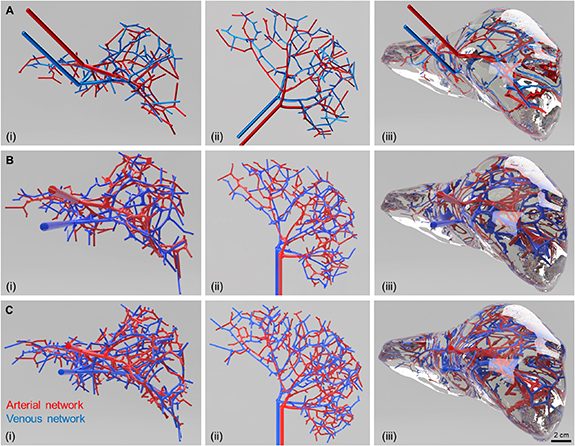
Read more
A Bidirectional Normalizing Flow Model of Brain Aging
Authors: Wilms, M., Bannister, J.J., Mouches, P., MacDonald, M.E., Rajashekar, D., Langner, S., and Forkert, N.D.
Date: 2022-03-24
Journal: IEEE Transaction on Medical Imaging: Volume 41, Issue 9
Many machine learning tasks in neuroimaging aim at modeling complex relationships between a brain’s morphology as seen in structural MR images and clinical scores and variables of interest. A frequently modeled process is healthy brain aging for which many image-based brain age estimation or age-conditioned brain morphology template generation approaches exist. While age estimation is a regression task, template generation is related to generative modeling. Both tasks can be seen as inverse directions of the same relationship between brain morphology and age. However, this view is rarely exploited and most existing approaches train separate models for each direction. In this paper, we propose a novel bidirectional approach that unifies score regression and generative morphology modeling and we use it to build a bidirectional brain aging model. We achieve this by defining an invertible normalizing flow architecture that learns a probability distribution of 3D brain morphology conditioned on age. The use of full 3D brain data is achieved by deriving a manifold-constrained formulation that models morphology variations within a low-dimensional subspace of diffeomorphic transformations. This modeling idea is evaluated on a database of MR scans of more than 5000 subjects. The evaluation results show that our bidirectional brain aging model (1) accurately estimates brain age, (2) is able to visually explain its decisions through attribution maps and counterfactuals, (3) generates realistic age-specific brain morphology templates, (4) supports the analysis of morphological variations, and (5) can be utilized for subject-specific brain aging simulation.
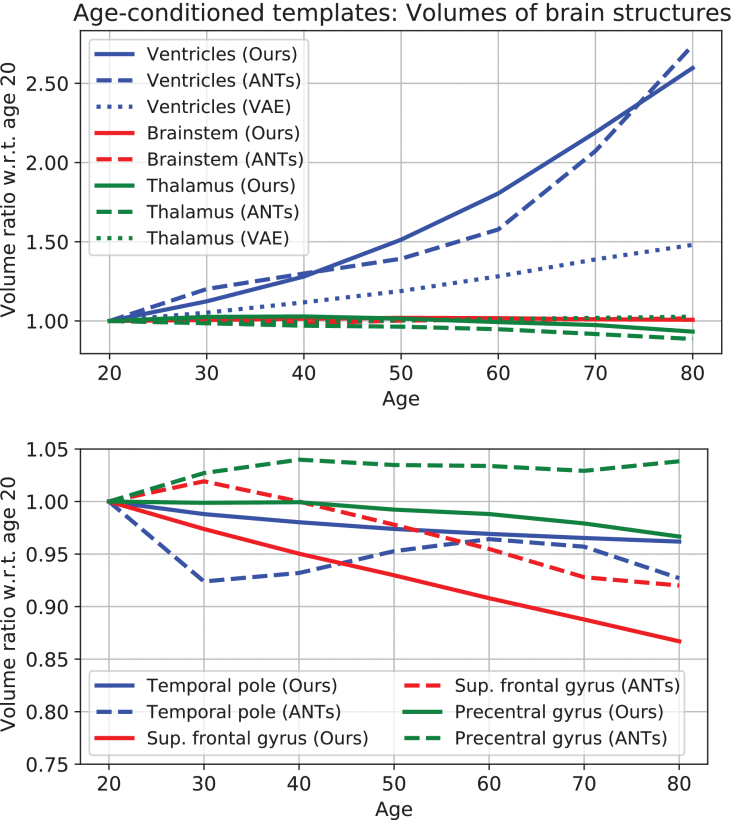
Read more
Lesion-symptom mapping with NIHSS sub-scores in ischemic stroke patients
Authors: Rajashekar, D., Wilms, M., MacDonald, M.E., Hill, M.D., Dukelow, S.P., and Forkert, N.D.
Date: 2021-11-25
Journal: Stroke & Vascular Neurology: Volume 7, Issue 2
Background:
Lesion-symptom mapping (LSM) is a statistical technique to investigate the population-specific relationship between structural integrity and post-stroke clinical outcome. In clinical practice, patients are commonly evaluated using the National Institutes of Health Stroke Scale (NIHSS), an 11-domain clinical score to quantitate neurological deficits due to stroke. So far, LSM studies have mostly used the total NIHSS score for analysis, which might not uncover subtle structure–function relationships associated with the specific sub-domains of the NIHSS evaluation. Thus, the aim of this work was to investigate the feasibility to perform LSM analyses with sub-score information to reveal category-specific structure–function relationships that a total score may not reveal.
Methods:
Employing a multivariate technique, LSM analyses were conducted using a sample of 180 patients with NIHSS assessment at 48-hour post-stroke from the ESCAPE trial. The NIHSS domains were grouped into six categories using two schemes. LSM was conducted for each category of the two groupings and the total NIHSS score.
Results:
Sub-score LSMs not only identify most of the brain regions that are identified as critical by the total NIHSS score but also reveal additional brain regions critical to each function category of the NIHSS assessment without requiring extensive, specialised assessments.
Conclusion:
These findings show that widely available sub-scores of clinical outcome assessments can be used to investigate more specific structure–function relationships, which may improve predictive modelling of stroke outcomes in the context of modern clinical stroke assessments and neuroimaging.
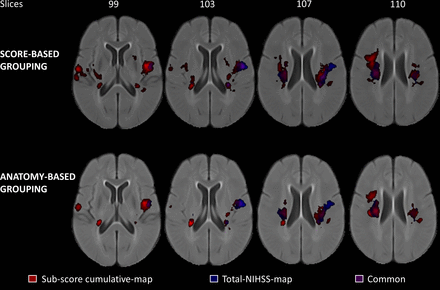
Read more
Magnetic Resonance Imaging of Healthy Brain Aging: A Review
Authors: MacDonald, M.E. and Pike, G.B.
Date: 2021-06-06
Journal: NMR in Biomedicine: Volume 34, Issue 9
We present a review of the characterization of healthy brain aging using MRI with an emphasis on morphology, lesions, and quantitative MR parameters. A scope review found 6612 articles encompassing the keywords “Brain Aging” and “Magnetic Resonance”; papers involving functional MRI or not involving imaging of healthy human brain aging were discarded, leaving 2246 articles. We first consider some of the biogerontological mechanisms of aging, and the consequences of aging in terms of cognition and onset of disease. Morphological changes with aging are reviewed for the whole brain, cerebral cortex, white matter, subcortical gray matter, and other individual structures. In general, volume and cortical thickness decline with age, beginning in mid-life. Prevalent silent lesions such as white matter hyperintensities, microbleeds, and lacunar infarcts are also observed with increasing frequency. The literature regarding quantitative MR parameter changes includes T1, T2, T2*, magnetic susceptibility, spectroscopy, magnetization transfer, diffusion, and blood flow. We summarize the findings on how each of these parameters varies with aging. Finally, we examine how the aforementioned techniques have been used for age prediction. While relatively large in scope, we present a comprehensive review that should provide the reader with sound understanding of what MRI has been able to tell us about how the healthy brain ages.
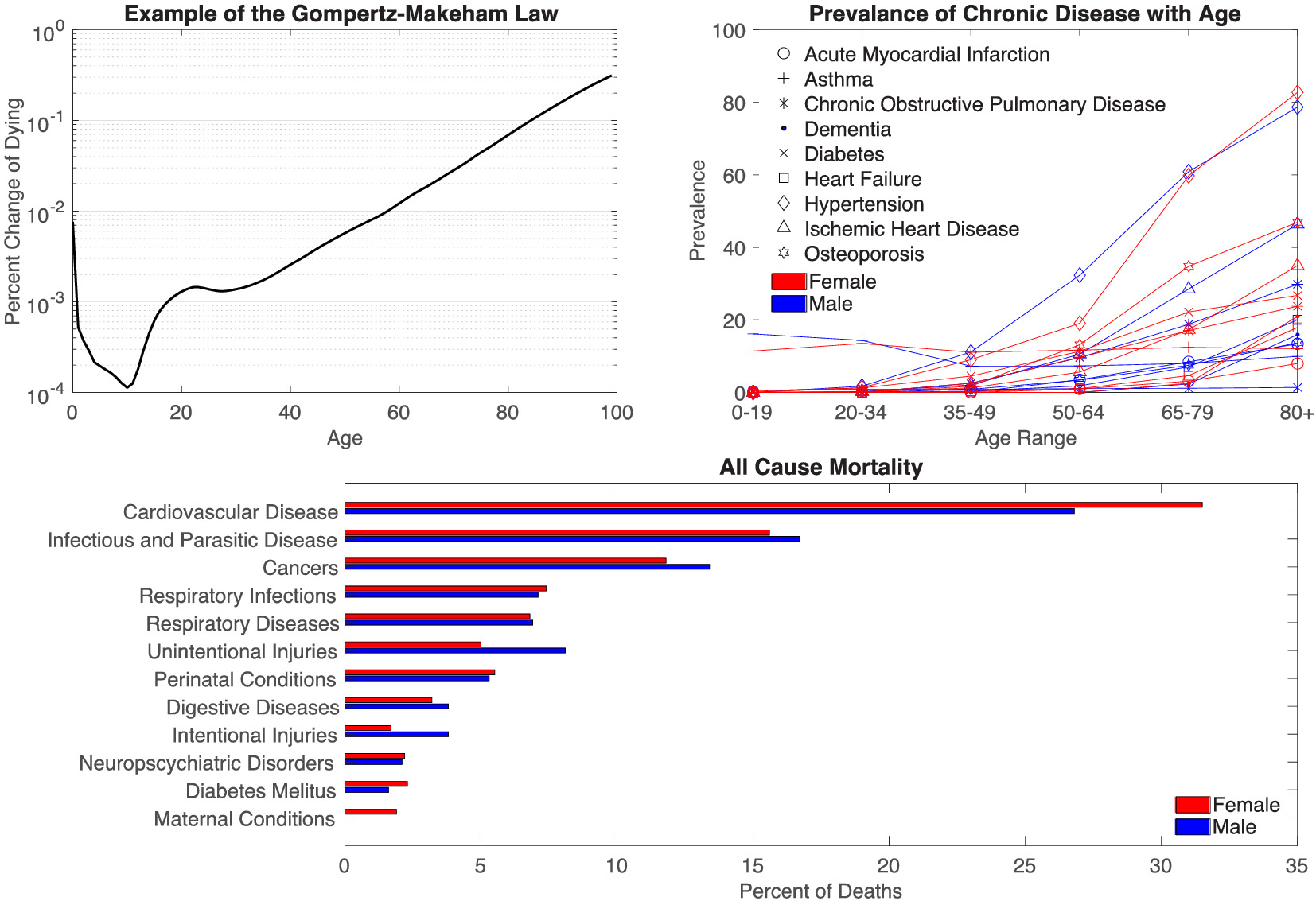
Read more
The relationship between cognition and cerebrovascular reactivity: Implications for cognitive fMRI
Authors: Williams, R.J., MacDonald, M.E., Mazerole, E.L., and Pike, G.B.
Date: 2021-04-11
Journal: Frontiers in Physics - Medical Physics and Imaging: Volume 9
Elucidating the brain regions and networks associated with cognitive processes has been the mainstay of task-based fMRI, under the assumption that BOLD signals are uncompromised by vascular function. This is despite the plethora of research highlighting BOLD modulations due to vascular changes induced by disease, drugs, and aging. On the other hand, BOLD fMRI-based assessment of cerebrovascular reactivity (CVR) is often used as an indicator of the brain's vascular health and has been shown to be strongly associated with cognitive function. This review paper considers the relationship between BOLD-based assessments of CVR, cognition and task-based fMRI. How the BOLD response reflects both CVR and neural activity, and how findings of altered CVR in disease and in normal physiology are associated with cognition and BOLD signal changes are discussed. These are pertinent considerations for fMRI applications aiming to understand the biological basis of cognition. Therefore, a discussion of how the acquisition of BOLD-based CVR can enhance our ability to map human brain function, with limitations and potential future directions, is presented.
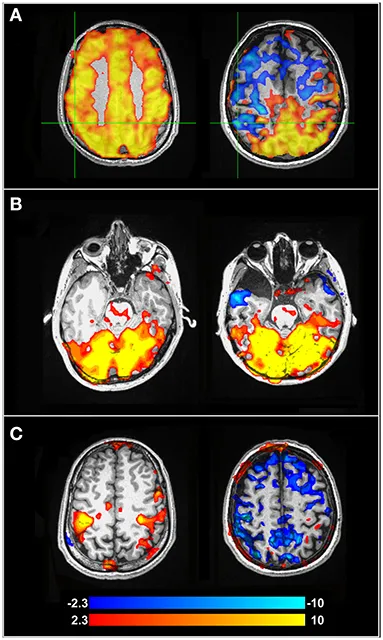
Read more
Supervised machine learning tools: a tutorial for clinicians
Authors: Lo Vercio, L., Amador, K., Bannister, J., Crites, S., Gutierrez, A., MacDonald, M.E., Moore, J., Mouches, P., Rajashekar, D., Schimert, S., Subbanna, N., Tuladhar, A., Wang, N., Wilms, M., Winder, A., and Forkert, N.D.
Date: 2020-11-19
Journal: Journal of Neural Engineering
In an increasingly data-driven world, artificial intelligence is expected to be a key tool for converting big data into tangible benefits and the healthcare domain is no exception to this. Machine learning aims to identify complex patterns in multi-dimensional data and use these uncovered patterns to classify new unseen cases or make data-driven predictions. In recent years, deep neural networks have shown to be capable of producing results that considerably exceed those of conventional machine learning methods for various classification and regression tasks. In this paper, we provide an accessible tutorial of the most important supervised machine learning concepts and methods, including deep learning, which are potentially the most relevant for the medical domain. We aim to take some of the mystery out of machine learning and depict how machine learning models can be useful for medical applications. Finally, this tutorial provides a few practical suggestions for how to properly design a machine learning model for a generic medical problem.
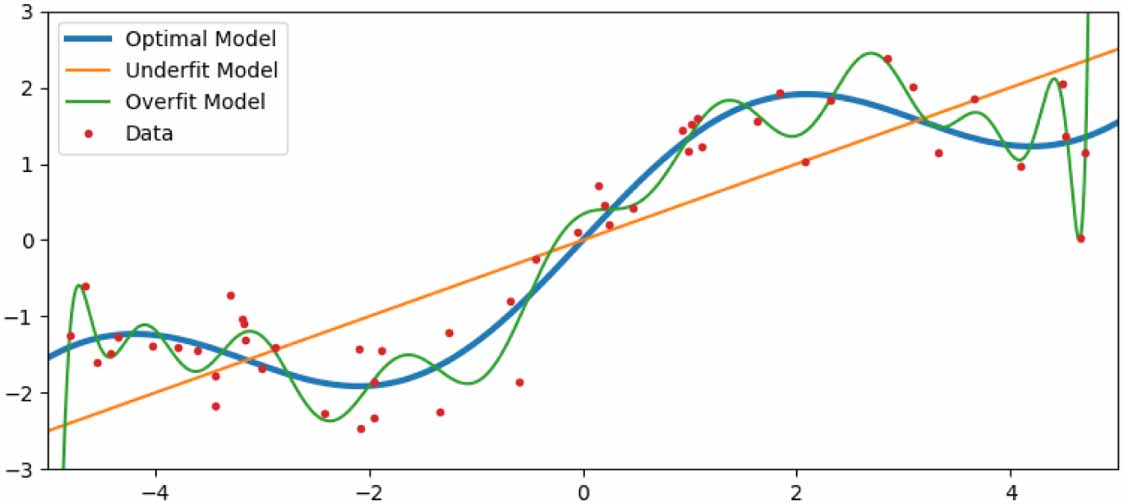
Read more
The Effect of Aging on Cerebral Blood Flow and Cortical Thickness with Application to Age Prediction
Authors: MacDonald, M.E., Williams, R.J., Rajashekar, D., Stafford, R.B.S., Hanganu, A., Sun, H., Berman, A.J.L., McCreary, C.M., Frayne, R., Forkert, N.D., and Pike, G.B.
Date: 2020-08-14
Journal: Neurobiology of Aging: Volume 95
Cerebral cortex thinning and cerebral blood flow (CBF) reduction are typically observed during normal healthy aging. However, imaging-based age prediction models have primarily used morphological features of the brain. Complementary physiological CBF information might result in an improvement in age estimation. In this study, T1-weighted structural magnetic resonance imaging and arterial spin labeling CBF images were acquired in 146 healthy participants across the adult life span. Sixty-eight cerebral cortex regions were segmented, and the cortical thickness and mean CBF were computed for each region. Linear regression with age was computed for each region and data type, and laterality and correlation matrices were computed. Sixteen predictive models were trained with the cortical thickness and CBF data alone as well as a combination of both data types. The age explained more variance in the cortical thickness data than in the CBF data . All 16 models performed significantly better when combining both measurement types and using feature selection, and thus, we conclude that the inclusion of CBF data marginally improves age estimation.
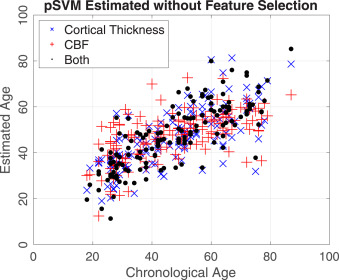
Read more
High-resolution T2-FLAIR and non-contrast CT brain atlas of the elderly
Authors: Rajashekar, D., Wilms, M., MacDonald, M.E., Ehrhardt, J., Mouches, P., Frayne, R., Hill, M., and Forkert, N.D.
Date: 2020-02-17
Journal: Scientific Data 7, Article Number 56
Normative brain atlases are a standard tool for neuroscience research and are, for example, used for spatial normalization of image datasets prior to voxel-based analyses of brain morphology and function. Although many different atlases are publicly available, they are usually biased with respect to an imaging modality and the age distribution. Both effects are well known to negatively impact the accuracy and reliability of the spatial normalization process using non-linear image registration methods. An important and very active neuroscience area that lacks appropriate atlases is lesion- related research in elderly populations (e.g. stroke, multiple sclerosis) for which FLAIR MRI and non- contrast CT are often the clinical imaging modalities of choice. To overcome the lack of atlases for these tasks and modalities, this paper presents high-resolution, age-specific FLAIR and non-contrast CT atlases of the elderly generated using clinical images.
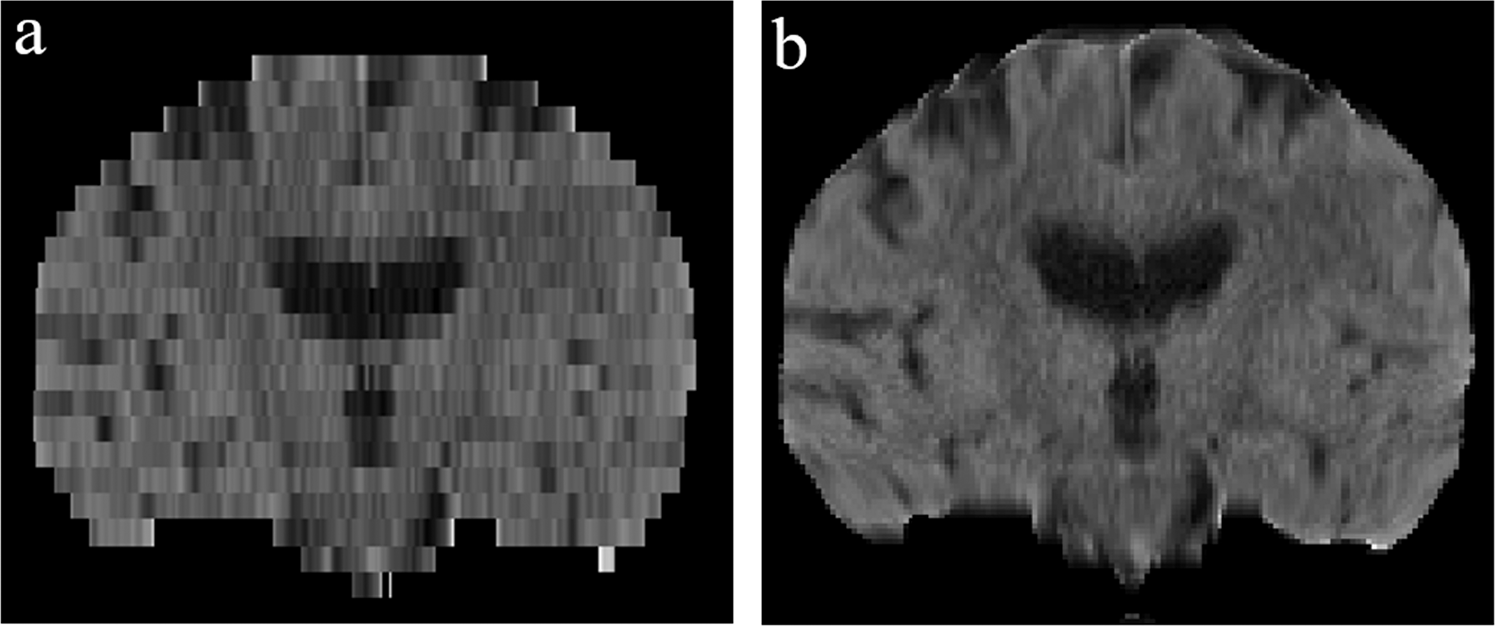
Read more
Interdatabase Variability of Cortical Thickness Measurements
Authors: MacDonald, M.E., Williams, R.J., Forkert, N.D., Berman, A.J.L., McCreary, C.R., Frayne, R., and Pike, G.B.
Date: 2019-08-23
Journal: Cerebral Cortex: Volume 29, Issue 8
The phenomenon of cortical thinning with age has been well established; however, the measured rate of change varies between studies. The source of this variation could be image acquisition techniques including hardware and vendor specific differences. Databases are often consolidated to increase the number of subjects but underlying differences between these datasets could have undesired effects. We explore differences in cerebral cortex thinning between 4 databases, totaling 1382 subjects. We investigate several aspects of these databases, including: 1) differences between databases of cortical thinning rates versus age, 2) correlation of cortical thinning rates between regions for each database, and 3) regression bootstrapping to determine the effect of the number of subjects included. We also examined the effect of different databases on age prediction modeling. Cortical thinning rates were significantly different between databases in all 68 parcellated regions (ANCOVA, P < 0.001). Subtle differences were observed in correlation matrices and bootstrapping convergence. Age prediction modeling using a leave-one-out cross-validation approach showed varying prediction performance between databases. When a database was used to calibrate the model and then applied to another database, prediction performance consistently decreased. We conclude that there are indeed differences in the measured cortical thinning rates between these large-scale databases.
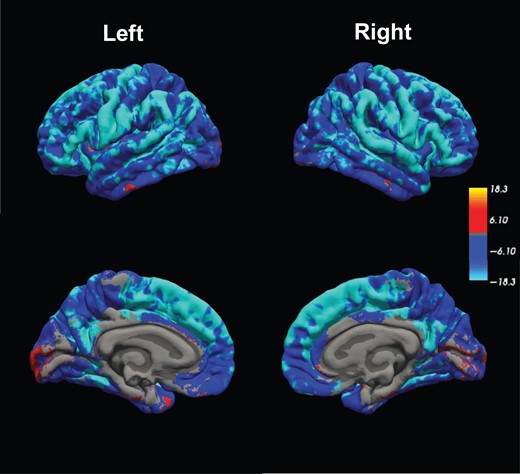
Read more
Whole Head Quantitative Susceptibility Mapping Using a Least-norm Direct Dipole Inversion Method
Authors: Sun, H., Ma, Y., MacDonald, M.E., and Pike, G.B.
Date: 2018-06-17
Journal: Neuroimage: Volume 179
A new dipole field inversion method for whole head quantitative susceptibility mapping (QSM) is proposed. Instead of performing background field removal and local field inversion sequentially, the proposed method performs dipole field inversion directly on the total field map in a single step. To aid this under-determined and ill-posed inversion process and obtain robust QSM images, Tikhonov regularization is implemented to seek the local susceptibility solution with the least-norm (LN) using the L-curve criterion. The proposed LN-QSM does not require brain edge erosion, thereby preserving the cerebral cortex in the final images. This should improve its applicability for QSM-based cortical grey matter measurement, functional imaging and venography of full brain. Furthermore, LN-QSM also enables susceptibility mapping of the entire head without the need for brain extraction, which makes QSM reconstruction more automated and less dependent on intermediate pre-processing methods and their associated parameters. It is shown that the proposed LN-QSM method reduced errors in a numerical phantom simulation, improved accuracy in a gadolinium phantom experiment, and suppressed artefacts in nine subjects, as compared to two-step and other single-step QSM methods. Measurements of deep grey matter and skull susceptibilities from LN-QSM are consistent with established reconstruction methods.
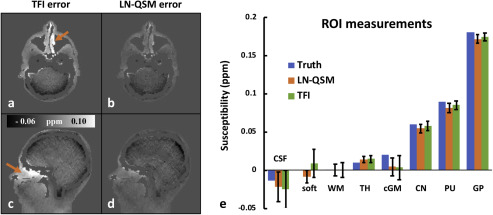
Read more
Modelling Hyperoxia-induced BOLD Signal Dynamics to Estimate Cerebral Blood Flow, Volume and Mean Transit Time
Authors: MacDonald, M.E., Berman, A.J.L., Williams, R.J., Mazerole, E.L., and Pike, G.B.
Date: 2018-06-05
Journal: NeuroImage: Volume 178
A new method is proposed for obtaining cerebral perfusion measurements whereby blood oxygen level dependent (BOLD) MRI is used to dynamically monitor hyperoxia-induced changes in the concentration of deoxygenated hemoglobin in the cerebral vasculature. The data is processed using kinetic modeling to yield perfusion metrics, namely: cerebral blood flow (CBF), cerebral blood volume (CBV), and mean transit time (MTT). Ten healthy human subjects were continuously imaged with BOLD sequence while a hyperoxic (70% O2) state was interspersed with baseline periods of normoxia. The BOLD time courses were fit with exponential uptake and decay curves and a biophysical model of the BOLD signal was used to estimate oxygen concentration functions. The arterial input function was derived from end-tidal oxygen measurements, and a deconvolution operation between the tissue and arterial concentration functions was used to yield CBF. The venous component of the CBV was calculated from the ratio of the integrals of the estimated tissue and arterial concentration functions. We conclude that it is possible to derive CBF, CBV and MTT metrics within expected physiological ranges via analysis of dynamic BOLD fMRI acquired during a period of hyperoxia.
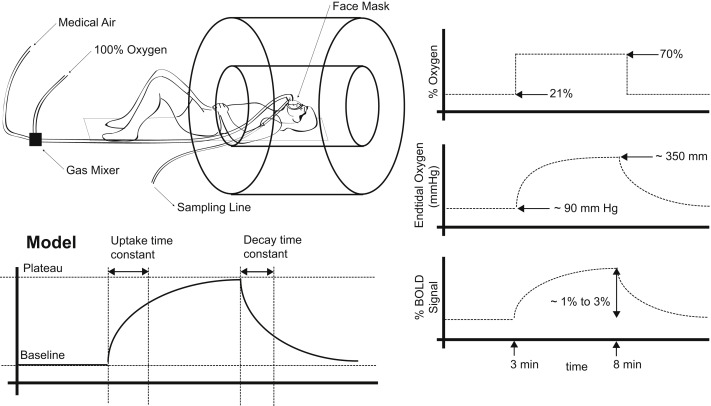
Read more
Gas- free Calibrated fMRI with a Correction for Vessel-Size Sensitivity
Authors: Berman, A.J.L., Mazerolle, E.L., MacDonald, M.E., Blockley, N.P., Luh, W., and Pike, G.B.
Date: 2017-12-20
Journal: NeuroImage: Volume 169
Calibrated functional magnetic resonance imaging (fMRI) is a method to independently measure the metabolic and hemodynamic contributions to the blood oxygenation level dependent (BOLD) signal. This technique typically requires the use of a respiratory challenge, such as hypercapnia or hyperoxia, to estimate the calibration constant, M. There has been a recent push to eliminate the gas challenge from the calibration procedure using asymmetric spin echo (ASE) based techniques. This study uses simulations to better understand spin echo (SE) and ASE signals, analytical modelling to characterize the signal evolution, and in vivo imaging to validate the modelling. Using simulations, it is shown how ASE imaging generally underestimates M and how this depends on several parameters of the acquisition, including echo time and ASE offset, as well as the vessel size. This underestimation is the result of imperfect SE refocusing due to diffusion of water through the extravascular environment surrounding the microvasculature. By empirically characterizing this SE attenuation as an exponential decay that increases with echo time, we have proposed a quadratic ASE biophysical signal model. This model allows for the characterization and compensation of the SE attenuation if SE and ASE signals are acquired at multiple echo times. This was tested in healthy subjects and was found to significantly increase the estimates of M across grey matter. These findings show promise for improved gas-free calibration and can be extended to other relaxation-based imaging studies of brain physiology.
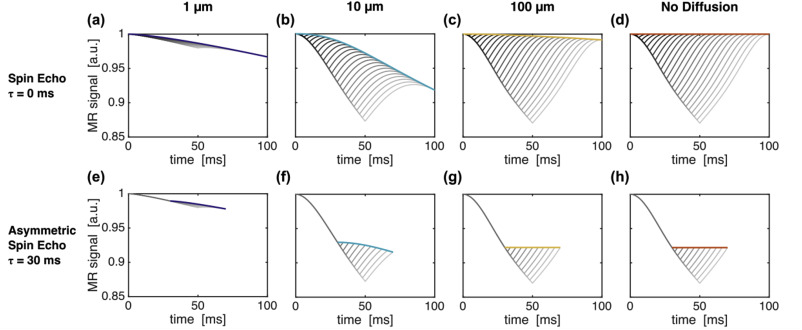
Read more
Dynamic Phase Contrast Magnetic Resonance Imaging for the Assessment of Arteriovenious Malformation and Aneurysm Pressure
Authors: MacDonald, M.E., Dolati, P., Mitha, A., Wong, J.H., and Frayne, R.
Date: 2016-08-25
Journal: Magnetic Resonance Imaging: Volume 34, Issue 9
Purpose: To explore phase contrast (PC) magnetic resonance imaging of aneurysms and arteriovenous malformations (AVM). PC imaging obtains a vector field of the velocity and can yield additional hemodynamic information, including: volume flow rate (VFR) and intravascular pressure. We expect to find lower VFR distal to aneurysms and higher VFR in vessels of the AVM.
Materials and Methods: Five cerebral aneurysm and three AVM patients were imaged with PC techniques and compared to VFR of a healthy cohort. VFR was calculated in vessel segments in each patient and compared statistically to the healthy cohort by computing the z-score. Intravascular pressure was calculated in the aneurysms and in the nidus of each AVM.
Results: We found that patients with aneurysm had z < −0.48 in vessels distal to the aneurysm (reduced flow), while AVM patients had z > 6 in some vessels supplying and draining the nidus (increased flow). Pressures in aneurysms were highly variable between subjects and location, while in the nidus of the AVM patients; pressure trended higher in larger AVMs.
Conclusion: The study findings confirm the expectation of lower distal flow in aneurysm and higher arterial and venous flow in AVM patients.
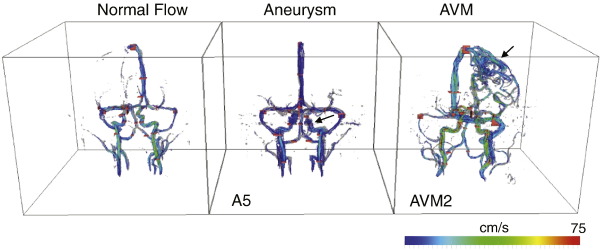
Read more
Phase Error Correction in Time-Averaged 3D Phase Contrast Magnetic Resonance Imaging of the Cerebral Vasculature
Authors: MacDonald, M.E., Forkert, N.D., Pike, G.B., and Frayne, R.
Date: 2016-02-24
Journal: Public Library of Science ONE 11(2)
Purpose:
Volume flow rate (VFR) measurements based on phase contrast (PC)-magnetic resonance (MR) imaging datasets have spatially varying bias due to eddy current induced phase errors. The purpose of this study was to assess the impact of phase errors in time averaged PC-MR imaging of the cerebral vasculature and explore the effects of three common correction schemes (local bias correction (LBC), local polynomial correction (LPC), and whole brain polynomial correction (WBPC)).
Methods:
Measurements of the eddy current induced phase error from a static phantom were first obtained. In thirty healthy human subjects, the methods were then assessed in background tissue to determine if local phase offsets could be removed. Finally, the techniques were used to correct VFR measurements in cerebral vessels and compared statistically.
Results:
In the phantom, phase error was measured to be <2.1 ml/s per pixel and the bias was reduced with the correction schemes. In background tissue, the bias was significantly reduced, by 65.6% (LBC), 58.4% (LPC) and 47.7% (WBPC) (p < 0.001 across all schemes). Correction did not lead to significantly different VFR measurements in the vessels (p = 0.997). In the vessel measurements, the three correction schemes led to flow measurement differences of -0.04 ± 0.05 ml/s, 0.09 ± 0.16 ml/s, and -0.02 ± 0.06 ml/s. Although there was an improvement in background measurements with correction, there was no statistical difference between the three correction schemes (p = 0.242 in background and p = 0.738 in vessels).
Conclusions:
While eddy current induced phase errors can vary between hardware and sequence configurations, our results showed that the impact is small in a typical brain PC-MR protocol and does not have a significant effect on VFR measurements in cerebral vessels.
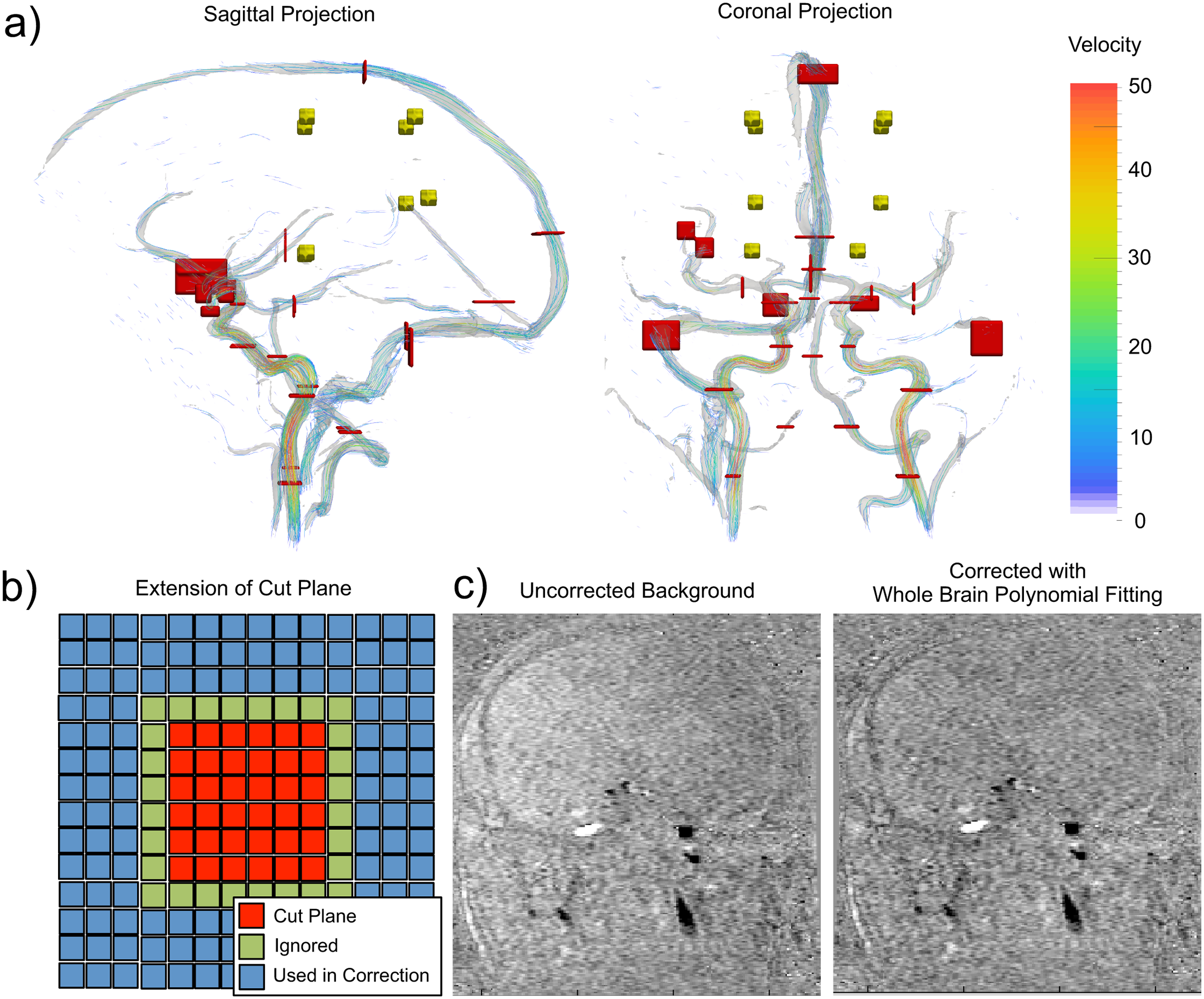
Read more
Hemodynamic alterations measured with phase-contrast MRI in a giant cerebral aneurysm treated with a flow-diverting stent
Authors: MacDonald, M.E., Dolati, P., Mitha, A., Essa, M., Wong, J.H., and Frayne, R.
Date: 2016-02-17
Journal: Radiology Case Reports: Volume 10, Issue 2
Many risk factors have been proposed in the development of the cerebral aneurysms. Hemodynamics including blood velocity, volume flow rate (VFR), and intravascular pressure are thought to be prognostic indicators of aneurysm development. We hypothesize that treatment of cerebral aneurysm using a flow-diverting stent will bring these hemodynamic parameters closer to those observed on the contralateral side. In the current study, a patient with a giant cerebral aneurysm was studied pre- and postoperatively using phase contrast MRI (PC-MRI) to measure the hemodynamic changes resulting from the deployment of a flow-diverting stent. PC-MRI was used to calculate intravascular pressure, which was compared to more invasive endovascular catheter-derived measurements. After stent placement, the measured VFRs in vessels of the treated hemisphere approached those measured on the contralateral side, and flow symmetry changed from a laterality index of -0.153 to 0.116 in the middle cerebral artery. Pressure estimates derived from the PC-MRI velocity data had an average difference of 6.1% as compared to invasive catheter transducer measurements. PC-MRI can measure the hemodynamic parameters with the same accuracy as invasive methods pre- and postoperatively.
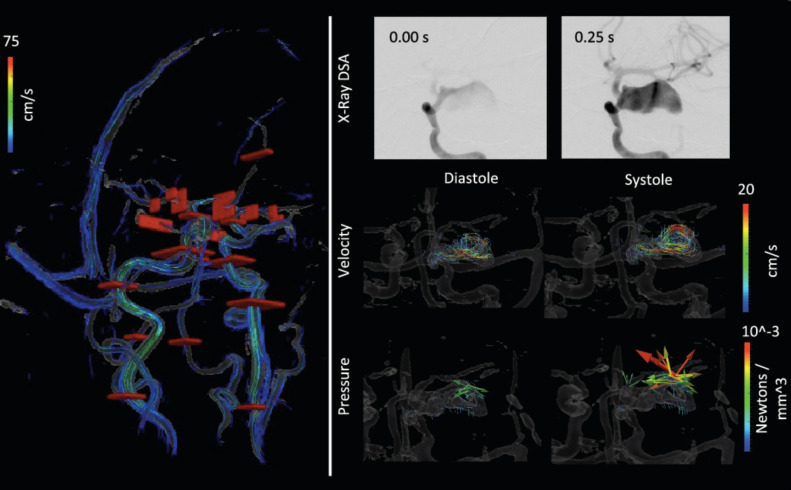
Read more
Phase Contrast MR Imaging Measurements of Blood Flow in Healthy Human Cerebral Vessel Segments
Authors: MacDonald, M.E. and Frayne, R.
Date: 2015-05-28
Journal: Physiological Measurement 36, Number 7
Phase contrast (PC) magnetic resonance imaging was used to obtain velocity measurements in 30 healthy subjects to provide an assessment of hemodynamic parameters in cerebral vessels. We expect a lower coefficient-of-variation (COV) of the volume flow rate (VFR) compared to peak velocity (Vpeak) measurements and the COV to increase in smaller caliber arteries compared to large arteries.
PC velocity maps were processed to calculate Vpeak and VFR in 26 vessel segments. The mean, standard deviation and COV, of Vpeak and VFR in each segment were calculated. A bootstrap-style analysis was used to determine the minimum number of subjects required to accurately represent the population. Significance of Vpeak and VFR asymmetry was assessed in 10 vessel pairs.
The bootstrap analysis suggested that averaging more than 20 subjects would give consistent results. When averaged over the subjects, Vpeak and VFR ranged from 5.2 ± 7.1 cm/s, 0.41 ± 0.58 ml/s (in the anterior communicating artery; mean ± standard deviation) to 73 ± 23 cm/s, 7.6 ± 1.7 ml/s (in the left internal carotid artery), respectively. A tendency for VFR to be higher in the left hemisphere was observed in 88.8% of artery pairs, while the VFR in the right transverse sinus was larger. The VFR COV was larger than Vpeak COV in 57.7% of segments, while smaller vessels had higher COV.
Significance and potential impact: VFR COV was not generally higher than Vpeak COV. COV was higher in smaller vessels as expected. These summarized values provide a base against which Vpeak and VFR in various disease states can be compared.
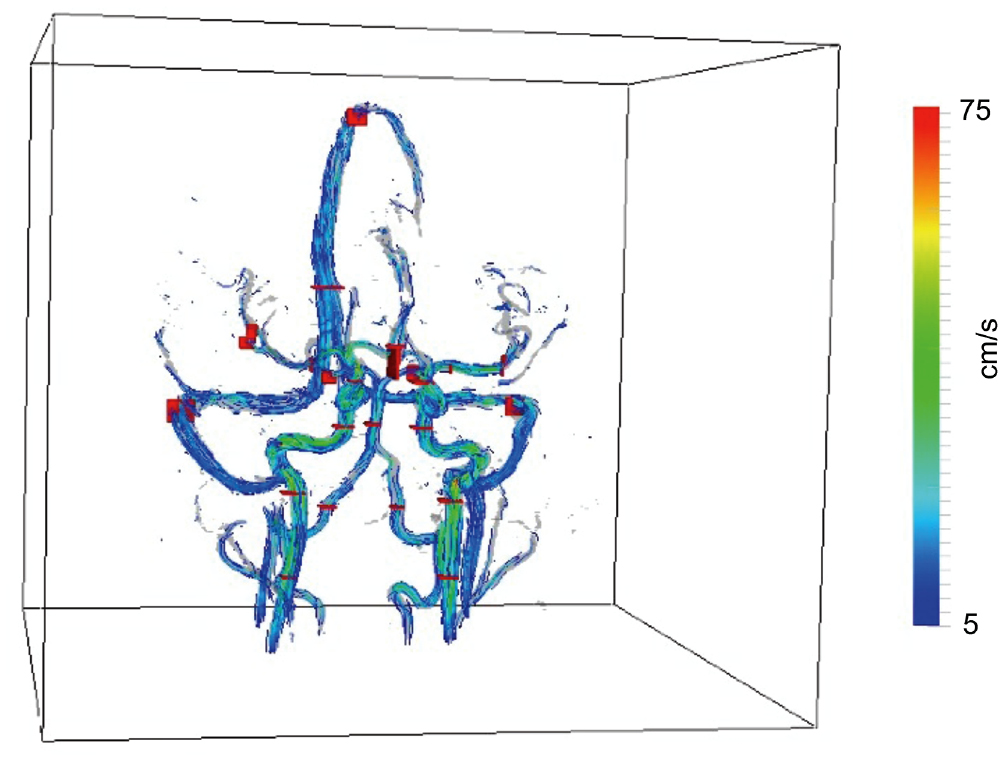
Read more
Magnetic Resonance Imaging: A Review of State-of-the-Art Approaches, Methods and Techniques
Authors: MacDonald, M.E. and Frayne, R.
Date: 2015-05-26
Journal: NMR in Biomedicine: Volume 28, Issue 7
Cerebrovascular imaging is of great interest in the understanding of neurological disease. MRI is a non-invasive technology that can visualize and provide information on: (i) the structure of major blood vessels; (ii) the blood flow velocity in these vessels; and (iii) the microcirculation, including the assessment of brain perfusion. Although other medical imaging modalities can also interrogate the cerebrovascular system, MR provides a comprehensive assessment, as it can acquire many different structural and functional image contrasts whilst maintaining a high level of patient comfort and acceptance. The extent of examination is limited only by the practicalities of patient tolerance or clinical scheduling limitations. Currently, MRI methods can provide a range of metrics related to the cerebral vasculature, including: (i) major vessel anatomy via time-of-flight and contrast-enhanced imaging; (ii) blood flow velocity via phase contrast imaging; (iii) major vessel anatomy and tissue perfusion via arterial spin labeling and dynamic bolus passage approaches; and (iv) venography via susceptibility-based imaging. When designing an MRI protocol for patients with suspected cerebral vascular abnormalities, it is appropriate to have a complete understanding of when to use each of the available techniques in the ‘MR angiography toolkit’. In this review article, we: (i) overview the relevant anatomy, common pathologies and alternative imaging modalities; (ii) describe the physical principles and implementations of the above listed methods; (iii) provide guidance on the selection of acquisition parameters; and (iv) describe the existing and potential applications of MRI to the cerebral vasculature and diseases. The focus of this review is on obtaining an understanding through the application of advanced MRI methodology of both normal and abnormal blood flow in the cerebrovascular arteries, capillaries and veins.
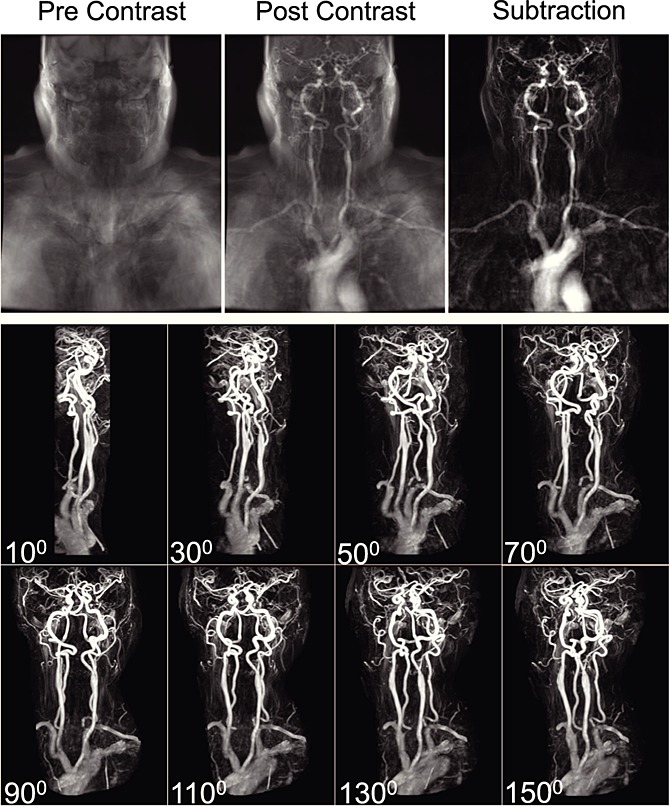
Read more
Accelerated Passive MR Catheter Tracking into the Carotid Artery of Canines Magnetic Resonance Imaging
Authors: MacDonald, M.E., Stafford, R.B., Yerly, J., Andersen, L., McCreary, C.M., and Frayne, R.
Date: 2012-08-13
Journal: Magnetic Resonance Imaging: Volume 31, Issue 1
Background:
Using magnetic resonance (MR) imaging for navigating catheters has several advantages when compared with the current “gold standard” modality of X-ray imaging. A significant drawback to interventional MR is inferior temporal and spatial resolutions, as high spatial resolution images cannot be collected and displayed at rates equal to X-ray imaging. In particular, passive MR catheter tracking experiments that use positive contrast mechanisms have poor temporal imaging rates and signal-to-noise ratio. As a result, with passive methods, it is often difficult to reconstruct motion artifact-free tracking images from areas with motion, such as the thoracic cavity.
Methods:
In this study, several accelerated MR acquisition strategies, including parallel imaging and compressed sensing (CS), were evaluated to determine which method is most effective at improving the frame rate and passive detection of catheters in regions of physiological motion. Device navigation was performed both in vitro, through the aortic arch of an anthropomorphic chest phantom, and in vivo from the femoral artery, up the descending aorta into the supra-aortic branching vessels in canines.
Results and Discussion:
The different parallel imaging methods produced images of low quality. CS with a two-fold acceleration was found to be the most effective method for generating tracking images, improving the image frame rate to 5.2 Hz, while maintaining a relatively high in-plane resolution. Using CS, motion artifact was decreased and the catheters were visualized with good conspicuity near the heart.
Conclusions:
The improvement in the imaging frame rate by image acceleration was sufficient to overcome motion artifacts and to better visualize catheters in the thoracic cavity with passive tracking. CS preformed best at tracking. Navigation with passive MR catheter tracking was demonstrated from the femoral artery to the carotid artery in canines.
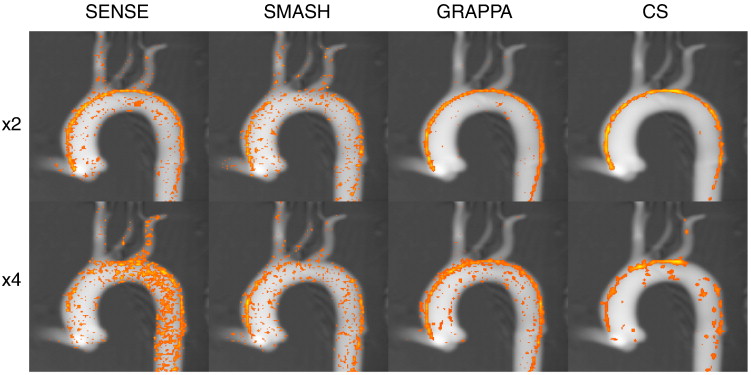
Read more
Closed-Loop Circulation Phantom with Heart and Lung Motion for Validating Passive Magnetic Resonance Catheter Tracking
Authors: Swailies, N.E., MacDonald, M.E., and Frayne, R.
Date: 2011-07-18
Journal: Journal of Magnetic Resonance Imaging: Volume 34, Issue 4
Purpose:
To develop an anthropomorphic phantom to simulate heart, lung, and blood motion. Magnetic resonance imaging (MRI) is sensitive to image distortion and artifacts caused by motion. Imaging phantoms are used to test new sequences, but generally, these phantoms lack physiological motion. For the validation of new MR-based endovascular interventional and other techniques, we developed a dynamic motion phantom that is suitable for initial in vitro and more realistic validation studies that should occur before animal experiments.
Materials and Methods:
An anthropomorphic phantom was constructed to model the thoracic cavity, including respiratory and cardiac motions, and moving blood. Several MRI methods were used to validate the phantom performance: anatomical scanning, rapid temporal imaging, digital subtraction angiography, and endovascular tracking. The quality and nature of the motion artifact in these images were compared with in vivo images.
Results:
The closed-loop motion phantom correctly represented key features in the thorax, was MR-compatible, and was able to reproduce similar motion artifacts and effects as seen in in vivo images. The phantom provided enough physiological realism that it was able to ensure a suitable challenge in an in vitro catheter tracking experiment.
Conclusion:
A phantom was created and used for testing interventional catheter guiding. The images produced had similar qualities to those found in vivo. This phantom had a high degree of appropriate anthropomorphic and physiological qualities. Ethically, use of this phantom is highly appropriate when first testing new MRI techniques prior to conducting animal studies.
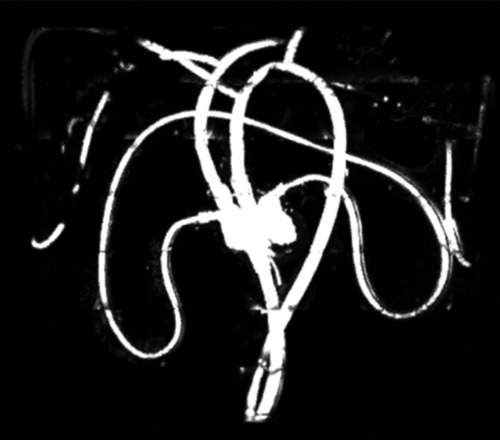
Read more
Deconvolution with Simple Extrapolation for Improved CBF Measurements in DSC-MRI during Acute Ischemic Stroke
Authors: MacDonald, M.E., Smith, M.R., and Frayne, R.
Date: 2011-05-05
Journal: Magnetic Resonance Imaging
Magnetic resonance (MR) perfusion imaging is a clinical technique for measuring brain blood flow parameters during stroke and other ischemic events. Ischemia in brain tissue can be difficult to accurately measure or visualize when using MR-derived cerebral blood flow (CBF) maps. The deconvolution techniques used to estimate flow can introduce a mean transit time-dependent bias following application of noise stabilization techniques. The underestimation of the CBF values, greatest in normal tissues, causes a decrease in the image contrast observed in CBF maps between normally perfused and ischemic tissues; resulting in ischemic areas becoming less conspicuous. Through application of the proposed simple extrapolation technique, CBF biases are reduced when missing high-frequency signal components in the MR data removed during deconvolution noise stabilization are restored. The extrapolation approach was compared with other methods and showed a statistically significant increase in image contrast in CBF maps between normal and ischemic tissues for white matter (P<.05) and performed better than most other methods for gray matter. Receiver operator characteristic curve analysis demonstrated that extrapolated CBF maps better-detected penumbral regions. Extrapolated CBF maps provided more accurate CBF estimates in simulations, suggesting that the approach may provide a better prediction of outcome in the absence of treatment.
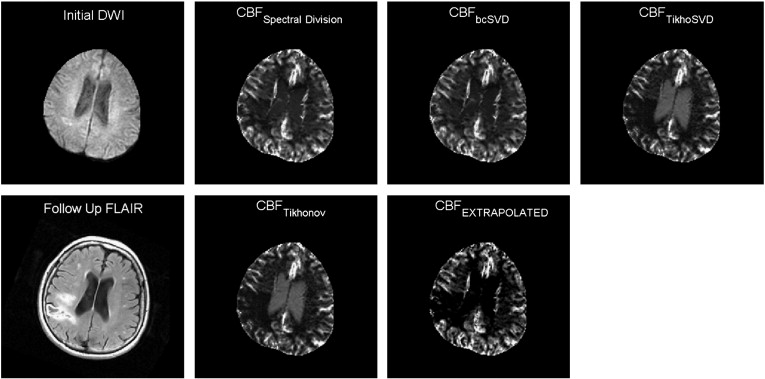
Read more
Conference Proceedings
Atlas-based Segmentation of Erosions in Cone-Beam Computed Tomography Images of Rheumatoid Arthritis Affected Hands
Authors: Al-Khoury, Y., Barber, C., Hazlewood, G., Finzel, S., Figueiredo, C., MacDonald, M.E., and Manske, S.
Date: 2024-11-03
Conference: 24th International Workshop on Quantitative Musculoskeletal Imaging (QMSKI)
Probabilistic Residual-Diffusion Model Based on Enhancing Gradually Incremental Stabilization for Medical Image Generative Tasks
Authors: Zhang, J., MacDonald, M.E., Qui, W., and Ganesh, A.
Date: 2024-10-06
Conference: 27th International Conference on Medical Image Computing and Computer Assisted Intervention (MICCAI)
The Useful Side of Motion: Using Head Motion Parameters to Correct for Respiratory Confounds in BOLD fMRI
Authors: Addeh, A., Pike, G.B., and MacDonald, M.E.
Date: 2024-09-03
Conference: International Society of Magnetic Resonance in Medicine (ISMRM)
nnUNet Segmentation of bones in CBCT images of the hand
Authors: Gahlot, Y., Al-Khoury, Y., MacDonald, M.E., and Manske, S.
Date: 2024-08-28
Conference: 2024 McCaig Institute Summer Student Symposium
Autonomous Mapping of Marrow Fat and Bone Structure with MRI
Authors: Nordholt, T., Garrido, Joseph Floer, Kuczynski, M., Morshed, A., MacDonald, M.E., and Whittier, D.
Date: 2024-08-28
Conference: 2024 McCaig Institute Summer Student Symposium
Machine Learning Estimation of Cerebrovascular Reactivity from Resting-State BOLD fMRI
Authors: Church, E., Addeh, A., Williams, R.J., Pike, G.B., and MacDonald, M.E.
Date: 2024-08-16
Conference: 2024 Biomedical Engineering Summer Student Symposium
Reducing Variability of Cerebral Blood Flow Between Sites using Data Harmonization
Authors: Hanley, J.Charatpangoon, P. ifUnderlineTraineesCharatpangoon, P., and MacDonald, M.E.
Date: 2024-08-16
Conference: 2024 Biomedical Engineering Summer Student Symposium
Autonomous Mapping of Marrow Fat and Bone Structure with MRI
Authors: Nordholt, T., Garrido, Joseph Floer, Kuczynski, M., Morshed, A., MacDonald, M.E., and Whit- tier, D.
Date: 2024-08-16
Conference: 2024 Biomedical Engineering Summer Student Symposium
Genetic Contributions to Brain Aging: A Machine Learning Analysis of UK Biobank Data
Authors: Spiian, A., Ardila, K., Mohite, A., Munro, E., and MacDonald, M.E.
Date: 2024-08-16
Conference: 2024 Biomedical Engineering Summer Student Symposium
Respiratory Rate and Head Motion Dynamics: A Frequency Analysis Across Different Life Stages Using the Human Connectome Project (HCP) Dataset
Authors: Addeh, A., Vega, F., Ardila, K., Williams, R.J., Pike, G.B., and MacDonald, M.E.
Date: 2024-06-23
Conference: 2024 OHBM Annual Meeting
Modelling the Impact of Genetics on the Aging of rfMRI Connectivity with Brain Age Gap Estimates using the UK Biobank
Authors: Ardila, K., Mohite, A., Munro, E., Vega, F., Curtis, C., Long, Q., and MacDonald, M.E.
Date: 2024-06-23
Conference: 2024 OHBM Annual Meeting
Method for Molecular-Level Monitoring of Microbial Populations and Elucidating Protein Expression Regulons via High-Throughput Quantitative Proteomics
Authors: Hepburn, M., Ulke-Lemee, A., Trescano, M., Walker, B.J., Earl, A.M., Grad, Y.H., Benediktsson, H., MacDonald, M.E., and I.A., Lewis.
Date: 2024-06-13
Conference: 2024 American Society of Microbiology - Microbe Annual Conference
Evolution of Microbial Populations in Calgary Over 6-years: Insights from a Comprehensive Multi-omics Analysis of 38,000 Bloodstream Pathogens
Authors: Lewis, I.A., Gregson, D., Earl, A.M., Grad, Y.H., Benediktsson, H., Walker, B.J., MacDonald, M.E., Mapar, M., Ulke-Lemee, A., Ramamourthy, G., Westlund, A., Pham, T.M., Valdez-Tresanco, M., MacKenzie, C., Mansuri, A., Hepburn, M., Plakhotnyk, A., Rydzak, T., Gilliland, R., and Groves, R.
Date: 2024-06-13
Conference: 024 American Society of Microbiology - Microbe Annual Conference
Silent Polymicrobial Infection: Prevalence of Same-Species Mixed Infections in 60 Staphylococcus aureus Bacteremias
Authors: Plakhotnyk, A., Mortimer, T.D., Valdez-Tresanco, M., Westlund, A., Walker, B.J., Ulke-Lemee, A., Mansuri, A., MacKenzie, C., Ramamourthy, G., Mapar, M., Hepburn, M., Rydzak, T., Gregson, D., Pham, T.M., Grad, Y.H., Earl, A.M., Smith, J.T., Gilliland, R., MacDonald, M.E., Benediktsson, H., Groves, R., and Lewis, I.A.
Date: 2024-06-13
Conference: 2024 American Society of Microbiology - Microbe Annual Conference
Decoding Bloodstream Infections: Insights from the Calgary BSI Cohort and the First Systematic Multi-omic Virulence Map
Authors: Ulke-Lemee, A., Gilliland, R., Valdés-Tresanco, M., Hepburn, M., Groves, R., Westlund, A., Plakhotnyk, A., Ramamourthy, G., Gregson, D., Pham, T.M., Mortimer, T.D., Smith, J.T., Walker, B.J., Grad, Y.H., Earl, A.M., Benediktsson, H., MacDonald, M.E., and Lewis, I.A.
Date: 2024-06-13
Conference: 2024 American Society of Microbiology - Microbe Annual Conference
Outcomes, Costs, and Severity of Bacteremia Caused by Related Pathogens that Cannot be Resolved via Current MALDI-TOF Mass Spectrometry Methods
Authors: Westlund, A., Walker, B.J., Plahotnyk, A., Ulke-Lemee, A., Morgan, C., Pham, T.M., Ramamourthy, G., Earl, A.M., Grad, Y.H., Benediktsson, H., MacDonald, M.E., and Lewis, I.A.
Date: 2024-06-13
Conference: 2024 American Society of Microbiology - Microbe Annual Conference.
LC-MS as a Platform for Precision Medicine: Accurately Predicting Survival from Bloodstream Infections using a Training Set of 38,000 Microbial Proteomes
Authors: Gilliland, R., Earl, A.M., Westlund, A., Walker, B.J., Plakhotnyk, A., Ulke-Lemee, A., MacKenzie, C., Hepburn, M., Pham, T.M., Ramamourthy, G., Grad, Y.M., Benediktsson, H., MacDonald, M.E., and Lewis, I.A.
Date: 2024-06-02
Conference: 2024 American Society of Mass Spectometry Annual Conference
Beyond the Biotyper: Leveraging LC-MS Proteomics to Systematically Map the Proteomes of 38,000 Bloodstream Infection isolates
Authors: Ulke-Lemee, A., Gilliland, R., Valdés-Tresanco, M., Hepburn, M., Groves, R., Westlund, A., Plakhotnyk, A., Ramamourthy, G., Gregson, D., Pham, T.M., Mortimer, T.D., Smith, J.T., Walker, B.J., Grad, Y.H., Earl, A.M., Benediktsson, H., MacDonald, M.E., and Lewis, I.A.
Date: 2024-06-02
Conference: 2024 American Society of Mass Spectometry Annual Conference
Radiation Dose Reduction in Brain Computed Tomography Perfusion of Acute Ischemic Stroke Patients Using a Denoising Autoencoder
Authors: Charatpangoon, P., Mohite, A., Menon, B., Ganesh, A, and MacDonald, M.E.
Date: 2024-05-27
Conference: 2024 IEEE-ISBI Annual Meeting.
Improving the Precision of Brain Age Gap Estimation Models with the Incorporation of Genetic Information using the UK Biobank
Authors: Mohite, A., Ardila, K., Charatpangoon, P., Munro, E., Long, Q., Curtis, C., and MacDonald, M.E.
Date: 2024-05-27
Conference: 2024 IEEE-ISBI Annual Meeting
Atlas-based Segmentation of Bone Erosions in CBCT Images of Rheumatoid Arthritis Affected Hands
Authors: Al-Khoury, Y., MacDonald, M.E., and Manske, S.
Date: 2024-05-23
Conference: 2024 Radiology Research Day
Atlas Construction and Validation using Healthy Hand Cone-Beam Computed Tomography Images
Authors: Al-Khoury, Y., MacDonald, M.E., and Manske, S.
Date: 2024-05-15
Conference: 2024 McCaig Research Day
Machine Learning-based Estimation of Respiratory Fluctuations in a Healthy Adult Population using BOLD fMRI and Head Motion Parameters
Authors: Addeh, A., Vega, F., Williams, R.J., Pike, G.B., and MacDonald, M.E.
Date: 2024-05-04
Conference: 2024 ISMRM Annual Meeting
Three-Dimensional Amyloid-Beta PET Synthesis from Structural MRI with Conditional Generative Adversarial Networks
Authors: Vega, F., Addeh, A., and MacDonald, M.E.
Date: 2024-05-04
Conference: 2024 ISMRM Annual Meeting
Sex Differences and Age-Related Decline in Absolute Cerebral Metabolic Rate of Oxygen (CMRO2) Consumption
Authors: Williams, R.J., Cohen, A., Lebel, R.M., MacDonald, M.E., Wang, Y., and Pike, G.B.
Date: 2024-05-04
Conference: 2024 ISMRM Annual Meeting
Leveraging Machine Learning to Study the Role of Genetics in Brain Age Gap Estimation: A Biomarker to Investigate Neurodegeneration
Authors: Mohite, A. and MacDonald, M.E.
Date: 2023-12-08
Conference: Neurosciences, Rehabilitation & Vision Strategic Clinical Network (NRV SCN) Research Summit
Applying Machine Learning on Low-Field Portable MRI to Improve Pediatric Imaging
Authors: Fadamiro, A., Vega, F., and MacDonald, M.E.
Date: 2023-12-07
Conference: 2023 ACHRI Research Retreat: One Child Every Child
Automatic Segmentation of Bone in Cone Beam CT Images
Authors: Al-Khoury, Y., MacDonald, M.E., and Manske, S.
Date: 2023-10-27
Conference: 24th Alberta Biomedical Engineering Conference
Modelling the Impact of Genetics on the Aging of Cerebral White Matter with Brain Age Gap Estimates using the UK Biobank
Authors: Ardila, K., Munro, E., Mohite, A., Curtis, C., Long, Q., and MacDonald, M.E.
Date: 2023-10-27
Conference: 24th Alberta Biomedical Engineering Conference
Brain Age Gap Estimation for Transient Ischemic Attack (TIA) Patients Using Deep Learning Model with T1-weighted Structural MRI
Authors: Charatpangoon, P., Mohite, A., Vega, F., McDougall, C., Barber, B., Ganesh, A., and MacDonald, M.E.
Date: 2023-10-27
Conference: 24th Alberta Biomedical Engineering Conference
Enhancing Prediction of Homelessness and Police Interaction Outcomes through Machine Learning Algorithms and Administrative Health Data Cohort Creation
Authors: Shahidi, F., MacDonald, M.E., Seitz, D., and Messier, G.
Date: 2023-10-27
Conference: 24th Alberta Biomedical Engineering Conference
Method to Increase Enrolment Rates in Stroke Clinical Trials Using Automatic Matching Algorithms
Authors: Charatpangoon, P., Singh, N., Almekhlafi, M.A., Swartz, R.H., Perera, K.S., Carrier, A., Menon, B.K., Ganesh, A, and MacDonald, M.E.
Date: 2023-10-10
Conference: 2023 World Stroke Congress
Multitask Deep Learning Model for Voxel-level Brain Age Gap Estimation
Authors: Gianchandani, N., MacDonald, M.E., and Souza, R. A
Date: 2023-10-08
Conference: 2023 Machine Learning in Medical Imaging (MLMI 2023) - MIC- CAI
Estimating Amyloid Beta from Magnetic Resonance Imaging
Authors: Vega, F., Addeh, A., and MacDonald, M.E.
Date: 2023-09-13
Conference: Alzhiemer’s Society of Alberta and the Northwest Territories - Hope for Tomorrow
Automatic Bone Segmentation of Hand Cone Beam CT Images Using an Edge-based Level-set Method
Authors: Al-Khoury, Y., MacDonald, M.E., and Manske, S.
Date: 2023-08-22
Conference: University of Calgary, Biomedical Undergraduate Research Symposium
A Computational Approach to Understand the Effect of Lesions in Thalamotomy for Essential Tremor
Authors: Hassan, S., Spiian, A., and MacDonald, M.E.
Date: 2023-08-22
Conference: University of Calgary, Biomedical Undergraduate Research Symposium
Bias Adjustment in Neuro-Imaging Based Brain Age Gap Estimation
Authors: Liang, C., Mohite, A., and MacDonald, M.E.
Date: 2023-08-15
Conference: University of Calgary, Heritage Youth Researcher Summer (HYRS) Program Symposium
Investigating Choroid Plexus-Driven Amyloid-Beta Aggregation in Patients with Alzheimer’s Disease
Authors: Wang, S., Ong, A., and MacDonald, M.E.
Date: 2023-08-15
Conference: University of Calgary, Heritage Youth Researcher Summer (HYRS) Program Symposium
Reframing the Brain Age Prediction Problem to a More Interpretable and Quantitative Approach
Authors: Gianchandani, N., Dibaji, M., Bento, N., MacDonald, M.E., and Souza, R.
Date: 2023-07-28
Conference: 2023 Interpretable Machine Learning in Healthcare
Direct Estimation of Respiratory Variation Waveforms All the Way to the Edge of fMRI Scans
Authors: Addeh, A., Vega, F., Williams, R.J., Pike, G.B., and MacDonald, M.E.
Date: 2023-07-22
Conference: 2023 Annual Organization of Human Brain Mapping
Amyloid-Beta PET Synthesis from Structural MRI: A Potential Alternative Method for Alzheimer’s Disease Screening
Authors: Vega, F., Addeh, A., and MacDonald, M.E.
Date: 2023-07-16
Conference: 2023 Alzheimer’s Association International Conference
Microbial Proteomic Traits Contribute to Staphylococcus aureus BSI Patient Mortality
Authors: Gilliland, R, Ulke-Lemee, A., Valdés-Tresanco, M.E., Westlund, A., Mansuri, A., Hepburn, M., Mortimer, T.D., Smith, J., Pham, T.M., Ramamourthy, G., Plakhotnyk, A., MacKenzie, C., Groves, R., Wacker, S., Rydzak, T., Mapar, M., Walker, B, Gregson, D, Grad, Y.H., Benediktsson, H, Earl, A.M., Lewis, I.A., and MacDonald, M.E.
Date: 2023-06-15
Conference: 2023 American Society of Microbiology Microbe
The Calgary BSI Cohort: guiding precision medicine from a 16-year multi-omics survey of infections
Authors: Lewis, I.A., Gregson, D, Clement, F., Earl, A., Grad, Y.H., Benediktsson, H., Walker, B., and MacDonald, M.E.
Date: 2023-06-15
Conference: 2023 American Society of Microbiology Microbe
A Genomic and Proteomic Survey of Traits that Modulate Antimicrobial Resistance in Staphylococcus aureus
Authors: MacKenzie, C., Hepburn, M., Mortimer, T.D., Smith, J.T., Valdes-Tresanco, M.E., Ulke-Lemee, A., Ramamourthy, G., Wacker, S., Mapar, M., Rydzak, T., Groves, R., Mansuri, A., Westlund, A., Plakhotnyk, A., Gilliland, R., Pham, T., Walker, B.J., MacDonald, M.E., Gregson, D.B., Earl, A.M., Grad, Y.H., Benediktsson, H., and Lewis, I.A.
Date: 2023-06-15
Conference: 2023 American Society of Microbiology Microbe
Prevalence Of Multi-strain Infections In Staphylococcus Aureus Bacteremia: Insights From A City-wide Survey
Authors: Plakhotnyk, A., Mortimer, T.D., Valdez-Tresanco, M., Westlund, A., Walker, B., Wacker, S., Ulke-Lemee, A., Mansuri, A., MacKenzie, C., Ramamourthy, G., Ma par, M., Hepburn, M., Rydzak, T., Gregson, D., Pham, T., Grad, Y., Earl, A., Smith, J., Gilliland, R., MacDonald, M.E., Hallgrimsson, B., Groves, R., and Lewis, I.A.
Date: 2023-06-15
Conference: 2023 American Society of Microbiology Microbe
Laying The Foundation For Virulence-guided Therapy: Insights From A City-wide Proteomics Survey Of Blood Stream Infections
Authors: Ulke-Lemee, A., Valdés-Tresanco, M.E., Gilliland, R., MacKenzie, C., Hepburn, M., Mapar, M., Groves, R., Mansuri, A., Plakhotnyk, A., Ramamourthy, G., Rydzak, T., Wacker, S., Westlund, A., Pham, T.M., Mortimer, T.D., Smith, J.T., Walker, B.J., Earl, A.M., Grad, Y.H., MacDonald, M.E., Gregson, D., and Lewis, I.A
Date: 2023-06-15
Conference: 2023 American Society of Microbiology Microbe
Outcomes and Antibiotic-Resistance Fluctuates in Rising Blood Stream Infections in Calgary, Alberta over a 16-year period
Authors: Westlund, A., Mansuri, A., Gregson, D., Wacker, S., Ulke-Lemee, A., Pham, T.M., Grad, Y.H., Benediktsson, H., Earl, A.M., MacDonald, M.E., Walker, B.J., and Lewis, I.A.
Date: 2023-06-15
Conference: 2023 American Society of Microbiology Microbe
Blood Stream Isolates: What’s in a Proteome?
Authors: Hepburn, M., Valdes-Tresanco, M.E., Gilliland, R., Westlund, A., Ulke-Lemee, A., Wacker, S., Mansuri, A., G, Ramamourthy, Rydzak, T., Smith, S.T., Plakhotnyk, A., Mackenzie, C., Mapar, M., Walker, B.J., Earl, A.M., Benediktsson, H., Gregson, D.B., MacDonald, M.E., and Lewis, I.A.
Date: 2023-06-04
Conference: 2023 American Society of Mass Spectometry Annual Conference
Mass spectrometry-guided precision medicine: a new frontier for clinical microbiology
Authors: Lewis, I.A., Gregson, D., Clement, F., Earl, A., Grad, Y.H., Benediktsson, H., Walker, B., and MacDonald, M.E.
Date: 2023-06-04
Conference: 2023 American Society of Mass Spectometry Annual Conference
Using BOLD-fMRI to Compute Respiration Volume per Time (RVT) and Respiration Variation (RV) with Convolutional Neural Network (CNN) in Children
Authors: Addeh, A., Vega, F., and MacDonald, M.E.
Date: 2023-06-03
Conference: 2023 Annual International Society of Magnetic Resonance in Medicine Scientific Meeting
Amyloid-Beta Axial Plane PET Synthesis from Structural MRI: An Image Translation Approach for Screening Alzheimer’s Disease
Authors: Vega, F., Addeh, A., Elmenshawi, A., and MacDonald, M.E.
Date: 2023-06-03
Conference: 2023 Annual International Society of Magnetic Resonance in Medicine Scientific Meeting
Denoising Simulated Low-Field MRI (70mT) using Denoising AutoEncoders (DAE) and Cycle Consistent Generative Adversarial Network (Cycle-GAN)
Authors: Vega, F., Addeh, A., and MacDonald, M.E.
Date: 2023-06-03
Conference: 2023 Annual International Society of Magnetic Resonance in Medicine Scientific Meeting
Limitations of the Derived Respiratory Variation Measurements used in Functional Magnetic Resonance Imaging
Authors: Addeh, A., Ardial Lopez, K., Vega, F., Golestani, A., and MacDonald, M.E.
Date: 2023-04-18
Conference: 2023 IEEE - International Symposium on Biomedical Imaging
Using Machine Learning to Study the Genetic Effects on Brain Aging in the UK Biobank
Authors: Ardila, K., Munro, E., Vega, F., Mohite, A., Curtis, C., Tyndall, A.V., and MacDonald, M.E.
Date: 2023-04-18
Conference: 2023 IEEE - International Symposium on Biomedical Imaging
A Deep Multi-Modal Cyber-Attack Detection in Industrial Control Systems
Authors: Bahadoripour, S., MacDonald, M.E., and Karimipour, H.
Date: 2023-04-04
Conference: 2023 IEEE - International Conference on Industrial Technology
The Diagnostic Relevance of Bloodstream Infection Host Factors
Authors: Gilliland, R., Ulke-Lemee, A., Valdes-Tresanco, M.E., Hepburn, M., Groves, R., MacKenzie, C., Mansuri, A., Mapar, M., Plakhotnyk, A., Ramamourthy, G., Rydzak, T., Westlund, A., Pham, T.M., Smith, J.T., Salamzade, R., Wacker, S., Mortimer, T., Walker, B.J., Gregson, D.B., Earl, A.M., Grad, Y.H., MacDonald, M.E., and Lewis, I.A.
Date: 2023-03-14
Conference: 2023 Large Scale Applied Research Project LSARP Retreat Meeting
Modeling the Impact of Genetics on Brain Aging: Identifying Genetic Associations with Age Gap Estimates using Neuroimaging and Genome Data from the UK Biobank
Authors: Ardilla, K., Munro, E., and MacDonald, M.E.
Date: 2023-03-09
Conference: 2023 Women in Data Science at the University of Calgary
Voxel-wise Brain Age Prediction to Assess Brain Aging using T1-Weighted MRI
Authors: Gianchandani, N., MacDonald, M.E., and Souza, R.
Date: 2023-03-09
Conference: 2023 Women in Data Science at the University of Calgary
Comparison of Machine Learning Models for Brain Age Gap Estimation with Few Inputs Features - Developing a Biomarker to Investigate the Role of Genetics in Neurodegeneration
Authors: Mohite, A., Ardilla, K., Munro, E., and MacDonald, M.E.
Date: 2023-03-09
Conference: 2023 Women in Data Science at the University of Calgary
Challenges of Respiratory Signals Measurement in fMRI Studies
Authors: Addeh, A., Vega, F., and MacDonald, M.E.
Date: 2022-10-21
Conference: 23rd Alberta Biomedical Engineering Conference
Using Machine Learning to Discover Genetic Effects on Brain Aging in the UK Biobank
Authors: Munro, E., Ardila, K., Mohite, A., Curtis, C., Tyndall, A.V., and MacDonald, M.E.
Date: 2022-10-21
Conference: 23rd Alberta Biomedical Engineering Conference
Using Deep Learning and Interpretable AI to Predict Outcomes in Medical Data
Authors: Osman Jakpa, A., Taib, M., Nguyen, B., MacDonald, M.E., and Messier, G.
Date: 2022-10-21
Conference: 23rd Alberta Biomedical Engineering Conference
Session-Based Recommender Systems and Hyper Parameter Optimization for Machine Learning of Administrative Data
Authors: Shahidi, F., MacDonald, M.E., and Messier, G.
Date: 2022-10-21
Conference: 23rd Alberta Biomedical Engineering Conference
Towards a Non-invasive Method for Screening Alzheimer’s Disease: Image Translation to Estimate Amyloid-Beta Positron from Structural MRI
Authors: Vega, F., Addeh, A., Elmenshawi, A., and MacDonald, M.E.
Date: 2022-10-21
Conference: 23rd Alberta Biomedical Engineering Conference
Enhancing the Preprocessing Pipeline for Image Translation Models to make Beta-Amyloid Positron Emission Tomography (PET) from Structural Magnetic Resonance Imaging (MRI)
Authors: Elmenshawi, A., Vega, F., and MacDonald, M.E.
Date: 2022-08-17
Conference: University of Calgary, Biomedical Undergraduate Research Symposium
Preliminary Work using Machine Learning to Discover Genetic Effects on Brain Aging in the UK Biobank
Authors: Munro, E., Ardila, K., Mohite, A., Curtis, C., and MacDonald, M.E.
Date: 2022-08-17
Conference: University of Calgary, Biomedical Undergraduate Research Symposium
Research Projects in the BIT Lab
Authors: Bowron, E., Addeh, A., Elmenshawi, A., Ardila Lopez, K., Medi, P., Mukherjee, S., Munro, E., Vega, F., and MacDonald, M.E.
Date: 2022-08-15
Conference: University of Calgary, Heritage Youth Researcher Summer (HYRS) Program Symposium
Preliminary Evidence of Two Dimensional Image Translation to Estimate Beta Amyloid PET from MRI
Authors: Vega, F., Addeh, A., and MacDonald, M.E.
Date: 2022-06-01
Conference: 30th Brain and Brain PET - ISCBFM Meeting
Preliminary Evidence of Two Dimensional Image Translation to Estimate Beta Amyloid PET from MRI
Authors: Vega, F., Addeh, A., and MacDonald, M.E.
Date: 2022-05-15
Conference: Hotchkiss Brain Institute Research Day
Simulation Evidence for use of a Denoising Auto-Encoder (DAE) to Improve Ultra-Low Field (64mT) MRI with a High Field (3T) Prior
Authors: MacDonald, M.E., Fikre, E., Vega, F., and Addeh, A.
Date: 2022-05-07
Conference: 31st ISMRM Annual Meeting
Regional variation in the linear relationship between breath-hold cerebrovascular reactivity and BOLD fMRI activation
Authors: Williams, R.J., Specht, J., MacDonald, M.E., and Pike, G.B.
Date: 2022-05-07
Conference: 31st ISMRM Annual Meeting
Convolutional Autoencoder for Denoising Low Dose CT Perfusion Maps
Authors: Fikre, E., Menon, B., and MacDonald, M.E.
Date: 2021-11-21
Conference: Canadian Undergraduate Biomedical Engineering Conference - Virtual Conference Organized at University of British Columbia
Reconstruction of Respiratory Volume Signal Variations Using BOLD Signals and Neural Network
Authors: Addeh, A., Chen, J.J., and MacDonald, M.E.
Date: 2021-10-22
Conference: 2021 Alberta Biomedical Engineering Conference
Lesion-deficit relationships defined using NIHSS sub-scores in acute ischemic stroke patients
Authors: Rajashekar, D., Wilms, M., MacDonald, M.E., Schimert, S., Hill, M., Goyal, M., Demchuk, A., Dukelow, S., and Forkert, N.D.
Date: 2021-05-22
Conference: 58th American Society of Neuroradiology Annual Meeting
Bidirectional Modeling and Analysis of Brain Aging with Normalizing Flows
Authors: Wilms, M., Bannister, J.J., Mouches, P., MacDonald, M.E., Rajashekar, D., and Forkert, N.D.
Date: 2020-10-04
Conference: Machine Learning in Clinical Neuroimaging at MICCAI
The Impact of Multiple Sclerosis Lesion Tract Burden on the Cortex
Authors: MacDonald, M.E., Scott, S., Liu, W.Q., Zhang, Y., Metz, L., and Pike, G.B.
Date: 2020-06-23
Conference: 26th OHBM Scientific Meeting
A Clustering Analysis of MS Lesions with T1-T2-weighted, Diffusion, QSM, and MTR Imaging
Authors: Scott, S., MacDonald, M.E., Rajashekar, D., Liu, W.Q., Sun, H., Metz, L., Zhang, Y., and Pike, G.B.
Date: 2020-06-23
Conference: 26th OHBM Scientific Meeting
Accelerated quantitative magnetization transfer (qMT) imaging using compressed sensing and parallel imaging
Authors: McLean, M.A., Lebel, R.M., MacDonald, M.E., Boudreau, M., and Pike, G.B.
Date: 2020-04-18
Conference: 28th ISMRM Scientific Meeting
Simultaneous T1-weighted imaging, R2* mapping, and QSM from a multi-echo MPRAGE sequence using a radial fan-beam sampling scheme at 3 Tesla
Authors: Sun, H., MacDonald, M.E., Lebel, R.M., and Pike, G.B.
Date: 2020-04-18
Conference: 28th ISMRM Scientific Meeting
Pilot Trial of Domperidone for Remyelination in Relapsing Remitting Multiple Sclerosis
Authors: Liu, W.Q., MacDonald, M.E., Pasha, R., Greenfield, J., Cerchiaro, G., Zhang, Y., Yong, V.W., Pike, G.B., and Metz, L.M.
Date: 2019-12-08
Conference: endMS Conference 2019
Machine learning methods for age prediction using cortical thickness and cerebral blood flow
Authors: MacDonald, M.E., Rajashekar, D., Williams, R.J., Sun, H., McCreary, C.R., Frayne, R., Forkert, N.D., and Pike, G.B.
Date: 2019-06-09
Conference: 25th OHBM Scientific Meeting
White Matter Tract-Defined Lesion Loads in Relapsing-Remitting Multiple Sclerosis
Authors: MacDonald, M.E., Liu, W.Q., Scott, S., Rockel, C.P., Rajashekar, D., Specht, J.L., Sun, H., and Pike, G.B.
Date: 2019-05-11
Conference: 27th ISMRM Scientific Meeting
Localization of GPi for MRgFUS pallidotomy: a comparison between high-resolution FGATIR, R2* and QSM at 3 T
Authors: Sun, H., MacDonald, M.E., Mazerolle, E.L., Sabourin, K., and Pike, G.B.
Date: 2019-05-11
Conference: 27th ISMRM Scientific Meeting
Accounting for vascular reactivity to clarify the role of the subcortical regions in attention
Authors: Williams, R.J., Specht, J., MacDonald, M.E., Lebel, R.M., Mazerolle, E.L., and Pike, G.B.
Date: 2018-06-17
Conference: 24th OHBM Scientific Meeting
Cerebrovascular Brain Aging Examined with Arterial Spin Labelling and Applied to Age Prediction
Authors: MacDonald, M.E., Forkert, N.D., Hanganu, A., Ma, Y., Williams, R.J., Sun, H., Stafford, R., McCreary, C.M., Frayne, R., and Pike, G.B.
Date: 2018-06-16
Conference: 26th ISMRM Scientific Meeting
Flow and metabolic coupling associated with positive and negative BOLD responses across retinotopic early visual cortices
Authors: Williams, R.J., Mazerolle, E.L., MacDonald, M.E., Berman, A.J.L., Luh, W.M., and Pike, G.B.
Date: 2017-06-08
Conference: 3rd Imaging Cerebral Physiology Symposium
Correcting for imperfect spin echo refocusing in gas-free fMRI calibration
Authors: Berman, A.J.L., Mazerolle, E.L., MacDonald, M.E., Blockley, N.P., Luh, W.M., and Pike, G.B.
Date: 2017-04-22
Conference: 25th ISMRM Scientific Meeting
Consistency of Inter-Database Cortical Thinning with Age
Authors: MacDonald, M.E., Williams, R.J., Forkert, N.D., Berman, A.J.L., McCreary, C.M., Frayne, R., and Pike, G.B.
Date: 2017-04-22
Conference: 25th ISMRM Scientific Meeting
Accelerated Z-Spectrum Imaging
Authors: McLean, M.A., MacDonald, M.E., Lebel, R.M., Boudreau, M., and Pike, G.B.
Date: 2017-04-22
Conference: 25th ISMRM Scientific Meeting
Sun, H., Ma, Y., MacDonald, M.E., and Pike, G.B.
Authors: Tikhonov regularization aided quantitative susceptibility mapping of whole brain without background field removal
Date: 2017-04-22
Conference: 25th ISMRM Scientific Meeting
Regularization-aided susceptibility inversion without background field removal
Authors: Sun, H., MacDonald, M.E., Ma, Y., and Pike, G.B.
Date: 2016-09-26
Conference: 4th Quantitative Susceptibility Mapping Workshop
Positive and negative BOLD and CBF responses across the early visual regions
Authors: Williams, R.J., Mazerolle, E., MacDonald, M.E., Luh, W.M., and Pike, G.B.
Date: 2016-06-26
Conference: 22nd Organization of Human Brain Mapping Annual Meeting
Dynamic Oxygen Passage Imaging for Perfusion Estimation
Authors: MacDonald, M.E.
Date: 2016-06-20
Conference: 2016 Alberta Imaging Symposium
Modeling Resting Cerebral Perfusion from BOLD Signal Dynamics During Hyperoxia
Authors: MacDonald, M.E., Berman, A.J.L., Williams, R.J., Mazerolle, E.L., and Pike, G.B.
Date: 2016-05-07
Conference: 24th ISMRM Scientific Meeting
Phase Correction of a Bipolar Gradient-Echo Acquisition for Quantitative Susceptibility Mapping
Authors: Sun, H., MacDonald, M.E., and Pike, G.B.
Date: 2016-05-07
Conference: 24th ISMRM Scientific Meeting
The Impact of Phase Errors on Mapping the Flow of the Cerebral Vasculature with Phase Contrast MRI
Authors: MacDonald, M.E., Forkert, N.D., Pike, G.B., and Frayne, R.
Date: 2015-06-14
Conference: 21st OHBM Scientific Meeting
Bold Oxygenation Level Dependence (BOLD) Quantitative Susceptibility Mapping (QSM) at Different Head Orientations
Authors: MacDonald, M.E., Berman, A.J.L., Williams, R.J., Mazerolle, E.L., and Pike, G.B.
Date: 2015-05-30
Conference: 23rd ISMRM Scientific Meeting
Overcoming the Image Position-Dependent Resolution Inherent in DFT and CS Reconstructions
Authors: Smith, M.R., Adipour, P., Woehr, J., and MacDonald, M.E.
Date: 2015-05-30
Conference: 23rd ISMRM Scientific Meeting
Imaging Aging with MRI
Authors: MacDonald, M.E.
Date: 2015-03-27
Conference: NSERC I3T CREATE Seminar Series
Quantitative Susceptibility Mapping in Human Brain with Normal Aging
Authors: Eilaghi, A., McLean, D.A., Gobbi, D.G., MacDonald, M.E., Lauzon, M.L., Salluzzi, M., and Frayne, R.
Date: 2014-10-06
Conference: 3rd International Workshop on MRI Phase Contrast & Quantitative Susceptibility Mapping
Comparing Blood Flow on Contralateral Sides of the Brain
Authors: MacDonald, M.E. and Frayne, R.
Date: 2014-09-16
Conference: 26th International Magnetic Resonance in Angiography Conference
Quantitative Susceptibility Mapping in Human Brain with Normal Aging
Authors: Eilaghi, A., McLean, D.A., Gobbi, D.G., MacDonald, M.E., Lauzon, M.L., Salluzzi, M., and Frayne, R.
Date: 2014-06-15
Conference: 7th Annual Molecular and Functional Imaging Symposium
Characterizing Magnetic Susceptibility Changes in the Human Brain in Normal Aging using Quantitative Susceptibility Mapping
Authors: Eilaghi, A., McLean, D.A., Gobbi, D.G., MacDonald, M.E., Lauzon, M.L., Salluzzi, M., and Frayne, R.
Date: 2014-06-15
Conference: 4th Alberta Imaging Symposium
Blood Flow through the Brain Measured with Phase Contrast MR Imaging
Authors: MacDonald, M.E. and Frayne, R.
Date: 2014-06-15
Conference: Department of Radiology Research Day
Imaging Battery for Brain Quantification
Authors: MacDonald, M.E., Lauzon, M.L., and Frayne, R.
Date: 2014-06-15
Conference: 4th Alberta Imaging Symposium
When “To DSP or not to DSP” in the context of Magnetic Resonance Imaging Reconstruction and Analysis
Authors: Smith, M.R., Adibpour, P., Woehr, J., and MacDonald, M.E.
Date: 2014-05-15
Conference: International and Industrial Imaging Training (I3T) Advanced Imaging Seminar Series
Measuring Volume Flow Rates of Cerebral Blood Vessels in Healthy Human Subjects and Arteriovenious Malformations using Phase Contrast MRI
Authors: Dolati, P., MacDonald, M.E., Wong, J.H., and Frayne, R.
Date: 2014-05-15
Conference: 82nd American Association of Neurological Surgeons
Blood Volume Flow Rates of Vessels in the Healthy Human Cerebral Vasculature
Authors: MacDonald, M.E., Dolati, P., Wong, J.H., and Frayne, R.
Date: 2014-05-10
Conference: 22nd ISMRM Scientific Meeting
Imaging Battery for Brain Quantification
Authors: MacDonald, M.E., Lauzon, M.L., and Frayne, R.
Date: 2014-05-10
Conference: 22nd ISMRM Scientific Meeting
Dual Compartmental Fitting of Dynamic Susceptibility Contrast MRI in Early Ischemic Stroke
Authors: MacDonald, M.E., Lee, E., Lee, T., Woehr, J., d’Esterre, C., Smith, M.R., and Frayne, R.
Date: 2014-05-10
Conference: 22nd ISMRM Scientific Meeting
Measuring Volume Flow Rates of Cerebral Blood Vessels in Healthy Human Subjects and Arteriovenious Malformations using Phase Contrast MRI
Authors: Dolati, P., MacDonald, M.E., Wong, J.H., and Frayne, R.
Date: 2014-04-15
Conference: Harvard neuroscience meeting
Susceptibility Changes in Human Brain during Normal Aging using Quantitative Susceptibility Mapping
Authors: Eilaghi, A., McLean, D.A., Gobbi, D.G., MacDonald, M.E., Lauzon, M.L., Salluzzi, M., and Frayne, R.
Date: 2014-03-24
Conference: 12th Imaging Network Ontario Symposium
Multimodal Quantitative MR Imaging in Acute Ischemic Stroke: Mapping Tissue Fate
Authors: Kosior, R.K., Mahajan, A., Trevedi, A., MacDonald, M.E., Frayne, R., and Barber, P.A.
Date: 2013-11-08
Conference: University of Calgary Leaders in Medicine Research Symposium
Improving Dynamic Contrast Enhanced MR Perfusion Measurements by Appropriate Selection of Acquisition Parameters
Authors: Lee, E., MacDonald, M.E., and Frayne, R.
Date: 2013-10-21
Conference: 25th International Workshop on Magnetic Resonance Angiography
Phase Contrast Magnetic Resonance Imaging in Cerebrovascular Malformations: Towards Pressure Estimation
Authors: MacDonald, M.E., Dolati, P., Mitha, A., Wong, J., and Frayne, R.
Date: 2013-10-21
Conference: 25th International Workshop on Magnetic Resonance Angiography
Enhanced Dynamic Contrast Enhanced (DCE) MR for Brain Perfusion Imaging
Authors: Lee, E., MacDonald, M.E., and Frayne, R.
Date: 2013-08-17
Conference: 4th Canadian Stroke Congress
Characterization of Cerebral Microbleeds using Quantitative Susceptibility Mapping: Role of Imaging Clinical Trials of Dementia and Small Vessel Disease
Authors: Eilaghi, A., MacDonald, M.E., McCreary, C.R., Lauzon, M.L., Smith, E.E., Gobbi, D.G., Salluzzi, M., and Frayne, R.
Date: 2013-06-27
Conference: 4th Molecular Function and Imaging Symposium
Impact of DFT Properties on the Inherent Resolution of Compressed Sensing Reconstruction Images
Authors: Smith, M.R., Woehr, J., Marasco, E., and MacDonald, M.E.
Date: 2013-06-20
Conference: 24th Irish Signals and Systems Conference
Phase Contrast in Cerebral Arteriovenious Malformations and Aneurysm
Authors: MacDonald, M.E.
Date: 2013-06-15
Conference: 3rd Alberta Imaging Symposium
Optimal Repetition Time Ranges for Dynamic Contrast Enhanced T1-weighted Magnetic Resonance Imaging
Authors: Lee, E., MacDonald, M.E., and Frayne, R.
Date: 2012-10-19
Conference: 13th Alberta Biomedical Engineering Conference
Arterial Spin Labeling Applications of Ischemic Stroke
Authors: MacDonald, M.E., Menon, B., Dolati, P., Goyal, M., and Frayne, R.
Date: 2012-09-29
Conference: 3rd Canadian Stroke Congress
The Cramer Rao Lower Bound of Magnetic Resonance Phase Image Acquisitions: Comparison with Bayesian Constrained Reconstruction
Authors: MacDonald, M.E., Swailes, N., Smith, M.R., Nielsen, J., and Frayne, R.
Date: 2012-09-23
Conference: Accelerated Magnetic Resonance Imaging 3rd International Workshop
Sensitivity of phase-contrast derived velocity and stress fields to receiver bandwidth at the circle of Willis
Authors: MacDonald, M.E., Dolati, P., Wong, J.H., Leung, T., Nielsen, J., and Frayne, R.
Date: 2012-09-19
Conference: 24th Annual International Magnetic Resonance Angiography Club Meeting
Acquisition and Reconstruction of MR Images for Quantitative Susceptibility Mapping
Authors: Swailes, N.E., MacDonald, M.E., and Frayne, R.
Date: 2012-08-15
Conference: 4th Seaman Family MR Research Centre Summer Student Symposium
A 3D Real-Time Magnetic Resonance Imaging Application to Visualize Contrast Inflow
Authors: Adair, D., MacDonald, M.E., and Frayne, R.
Date: 2012-06-15
Conference: 2nd Alberta Imaging Symposium
Real-Time 3D MRI with Random Undersampling Trajectories to Visualize Endovascular Catheters and Contrast Inflow
Authors: MacDonald, M.E.
Date: 2012-06-15
Conference: 4th Annual Radiology Research Dinner
Real-Time 3D MRI with Random Undersampling Trajectories to Visualize Endovascular Catheters and Contrast Inflow
Authors: MacDonald, M.E., Adair, D., Dolati, P., Yerly, J., and Frayne, R.
Date: 2012-06-15
Conference: 2nd Alberta Imaging Symposium
Measurement of Perfusion during Transient Carotid Occlusion
Authors: MacDonald, M.E., Dolati, P., Andersen, L.B., McCreary, C.R., Wong, J., and Frayne, R.
Date: 2012-05-05
Conference: 2nd Alberta Imaging Symposium
Quantitative Susceptibility Mapping as an Improved Biomarker for Cerebral Microbleeds in Small Vessel Disease
Authors: Beladi, S., McCreary, C.R., Smith, E.E., Lauzon, M.L., MacDonald, M.E., and Frayne, R.
Date: 2012-05-05
Conference: 20th ISMRM Scientific Meeting
Real-Time 3D MRI with Random Undersampling Trajectories to Visualize Endovascular Catheters and Contrast Inflow
Authors: MacDonald, M.E., Adair, D., Dolati, P., Yerly, J., and Frayne, R.
Date: 2012-05-05
Conference: 20th ISMRM Scientific Meeting
Measurement of Perfusion during Transient Carotid Occlusion
Authors: MacDonald, M.E., Dolati, P., Anderson, L., McCreary, C.R., Wong, J.H., and Frayne, R.
Date: 2012-05-05
Conference: 20th ISMRM Scientific Meeting
A 3D Real-Time Magnetic Resonance Imaging Application to Visualize Contrast Inflow
Authors: Adair, D., MacDonald, M.E., and Frayne, R.
Date: 2011-10-21
Conference: 12th Alberta Biomedical Engineering Meeting
Catheter Tracking using Passive Magnetic Resonance Imaging into the Ascending Aorta
Authors: MacDonald, M.E., Anderson, L.B., McCreary, C.R., and Frayne, R.
Date: 2011-09-25
Conference: 23rd International Magnetic Resonance Angiography Club Meeting
Which 1980’s and 1990’s super-resolution reconstruction ideas would prove useful when 2011’s compressed sensing reconstruction is used for MR sparse angiography?
Authors: Smith, M.R., MacDonald, M.E., Marasco, E., Salluzzi, M., Gauderon, P., and Frayne, R.
Date: 2011-09-25
Conference: 23rd International Magnetic Resonance Angiography Club Meeting
Implementation and Applications of Real-time 3D Magnetic Resonance Imaging
Authors: Adair, D., MacDonald, M.E., and Frayne, R.
Date: 2011-08-15
Conference: 3rd Seaman Family MR Research Centre Summer Student Symposium
Determining the Cramer Rao Lower Bound of Magnetic Resonance Imaging
Authors: MacDonald, M.E., Lauzon, M.L., Nielsen, J., and Frayne, R.
Date: 2011-07-31
Conference: Joint American Association of Medical Physicists (AAPM) and Canadian Organization of Medical Physicists (COMP) Scientific Meeting
Improving CBF Image Contrast with Frequency Extrapolation for DSC-MRI during Acute Stroke
Authors: MacDonald, M.E., Smith, M.R., and Frayne, R.
Date: 2011-05-07
Conference: 19th ISMRM Scientific Meeting
Guidance to the Branching Vessels of the Aortic Arch with Passive MR Catheter Tracking
Authors: MacDonald, M.E., Swailes, N., Andersen, L.B., McCreary, C.R., and Frayne, R.
Date: 2011-05-07
Conference: 19th ISMRM Scientific Meeting
Numerical Simulations to Evaluate the CRLB in MRI
Authors: MacDonald, M.E., Lauzon, M.L., Nielsen, J., and Frayne, R.
Date: 2011-04-15
Conference: Advanced Imaging Reconstruction Workshop. Natural Sciences and Engineering Research Council (NSERC) Collaborative Research and Training Experience Program (CREATE)
Catheter Tracking using Passive Magnetic Resonance Imaging into the Ascending Aorta
Authors: MacDonald, M.E., Swailes, N.E., Stafford, R.B., Andersen, L.B., McCreary, C.R., and Frayne, R.
Date: 2010-10-22
Conference: 11th Alberta Biomedical Engineering Meeting
Closed-Loop Circulation Phantom with Heart and Lung Motion for Validating Passive Catheter Tracking
Authors: Swailes, N.E., MacDonald, M.E., and Frayne, R.
Date: 2010-10-22
Conference: 11th Alberta Biomedical Engineering Meeting
Circulation Phantom with Closed-Loop Heart and Lung Motion
Authors: Swailes, N.E., MacDonald, M.E., and Frayne, R.
Date: 2010-08-15
Conference: 2nd Seaman Family MR Research Summer Student Symposium
Real Time Magnetic Resonance Imaging for Passive Catheter Tracking
Authors: MacDonald, M.E.
Date: 2010-06-15
Conference: 2nd Annual Radiology Research Dinner
One step real-time image correction with GUSTO (Gradient-warp and UnderSampling Transform Operator)
Authors: MacDonald, M.E., Stafford, R.B., Lauzon, M.L., and Frayne, R.
Date: 2010-05-01
Conference: 18th ISMRM Scientific Meeting
Real-Time Gradient Warp Correction with OpenGL NURBS Surfaces
Authors: Stafford, R.B., MacDonald, M.E., and Frayne, R.
Date: 2010-05-01
Conference: 18th ISMRM Scientific Meeting
Portraying Vocalism with Magnetic Resonance Technology
Authors: Sevick, L., MacDonald, M.E., Stafford, R.B., Bell, D., and Frayne, R.
Date: 2009-08-15
Conference: 1st Seaman Family MR Research Summer Student Symposium
Real Time Magnetic Resonance Imaging for Angioplasty
Authors: MacDonald, M.E., Stafford, R.B., and Frayne, R.
Date: 2009-07-21
Conference: 55th Annual Canadian Organization of Medical Physicists Scientific Conference
Extrapolation Methods for Improving MR Perfusion Measurements
Authors: MacDonald, M.E., Frayne, R., and Smith, M.R
Date: 2009-05-15
Conference: 32nd Canadian Medical and Biological Engineering Conference
Fourier Domain Extrapolation to Improve Cerebral Blood Flow Accuracy
Authors: MacDonald, M.E., Frayne, R., and Smith, M.R.
Date: 2008-10-24
Conference: 9th Alberta Biomedical Engineering Meeting
Using Fourier Domain Extrapolation to Improve Cerebral Blood Flow Accuracy
Authors: MacDonald, M.E., Frayne, R., and Smith, M.R.
Date: 2008-08-15
Conference: Biomedical Engineering Summer Student Symposium
























